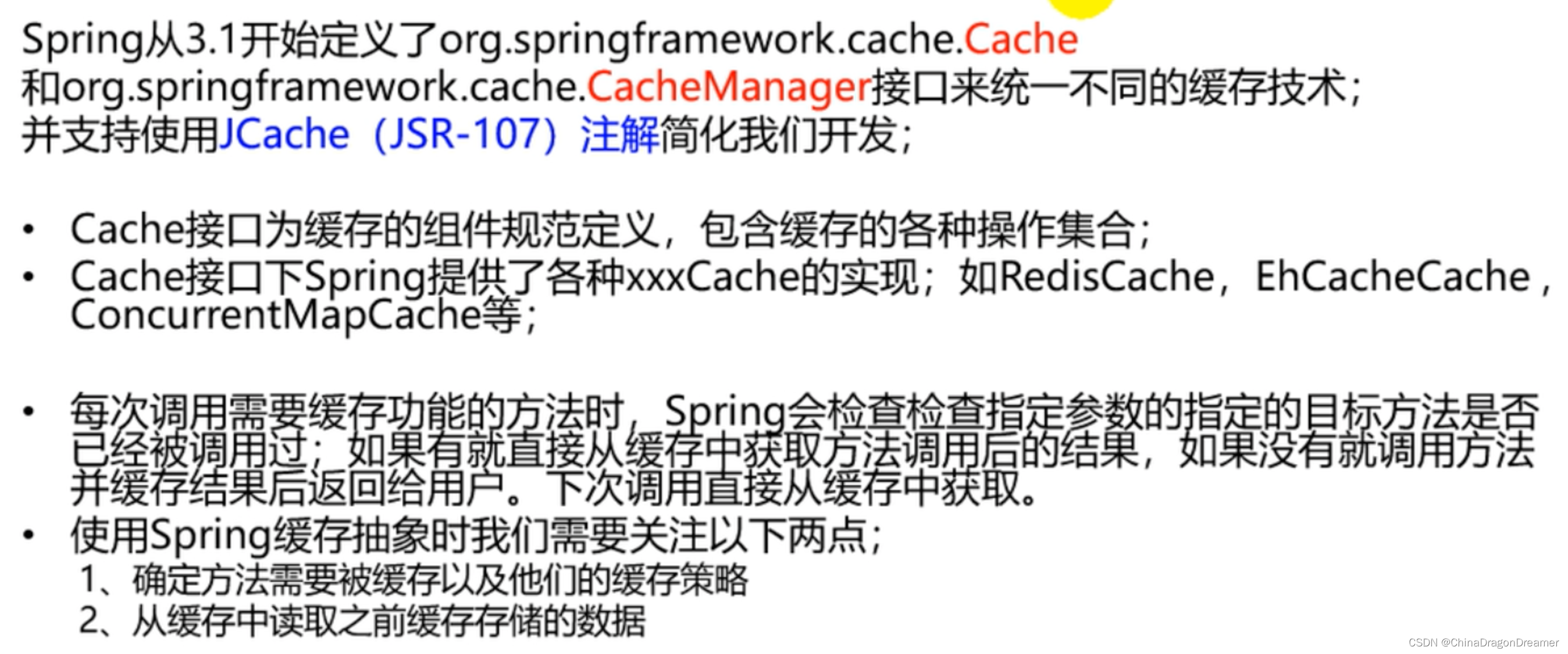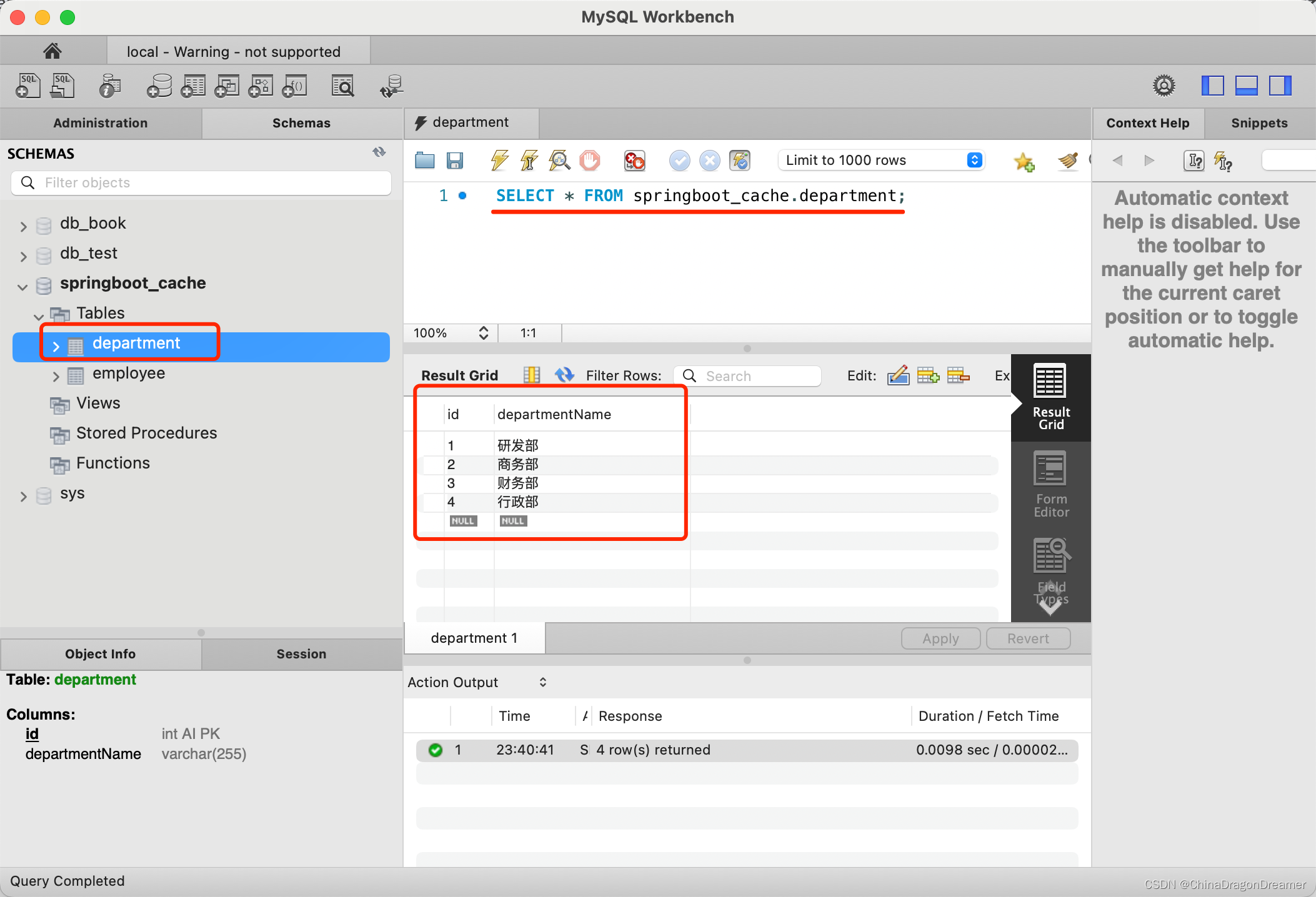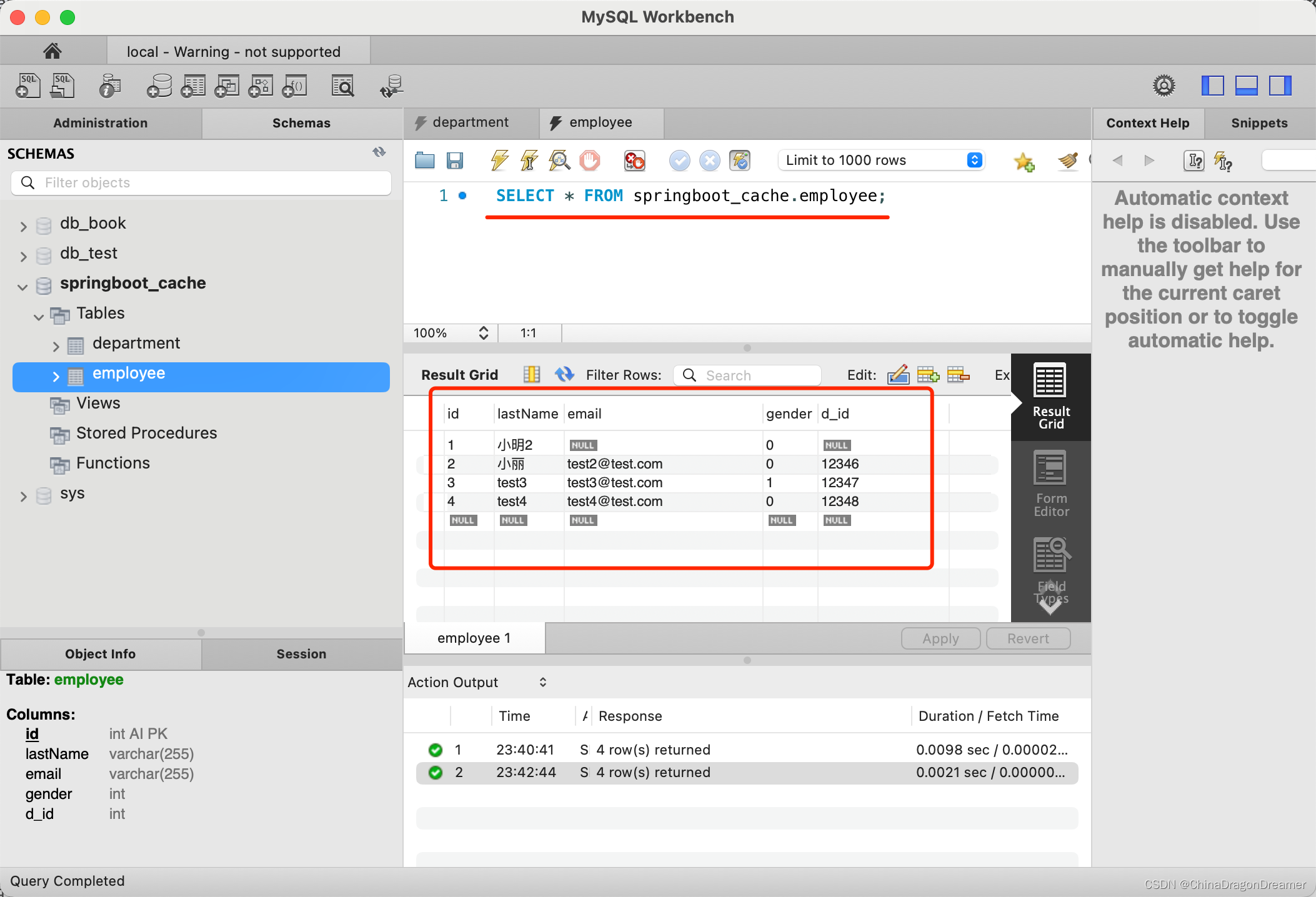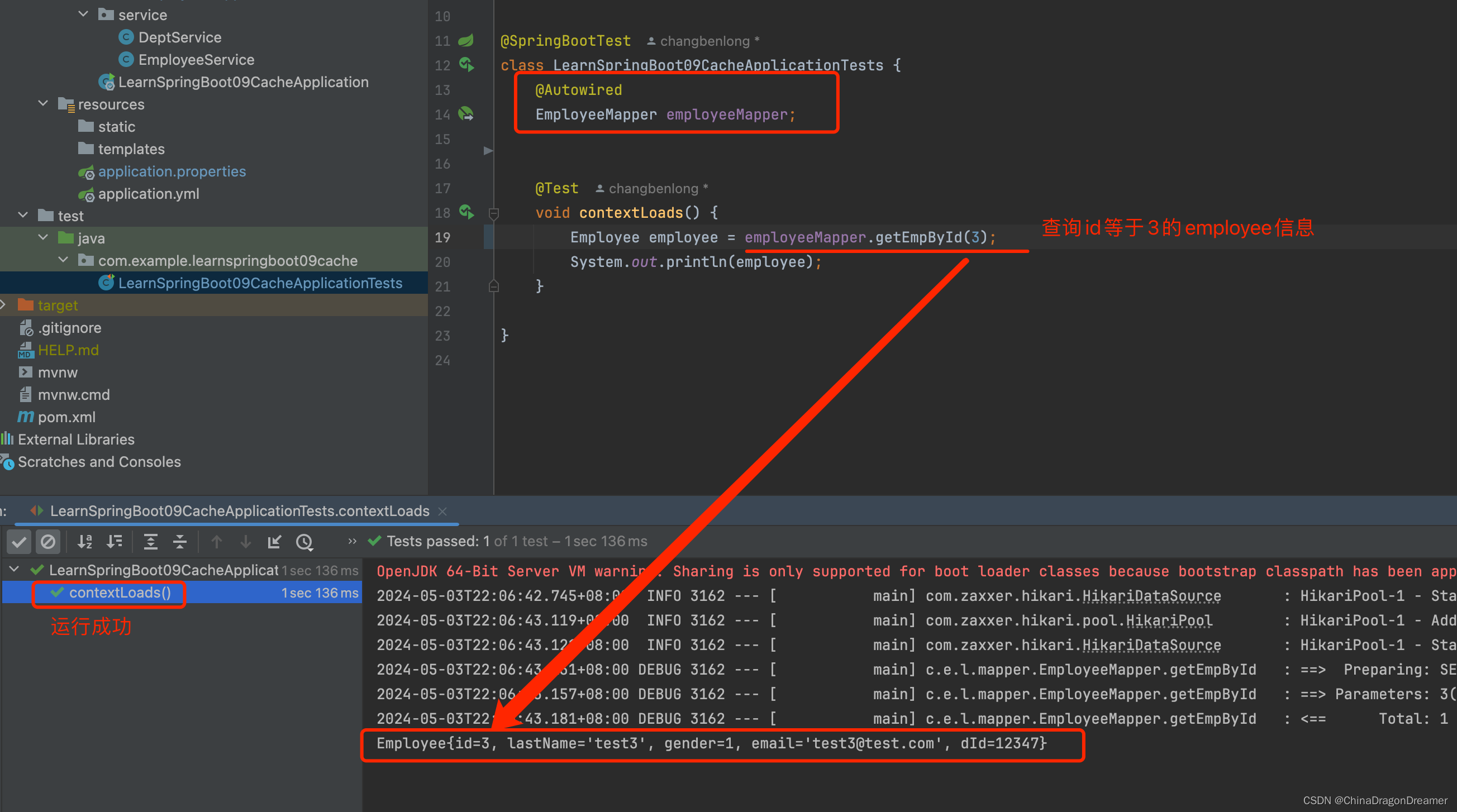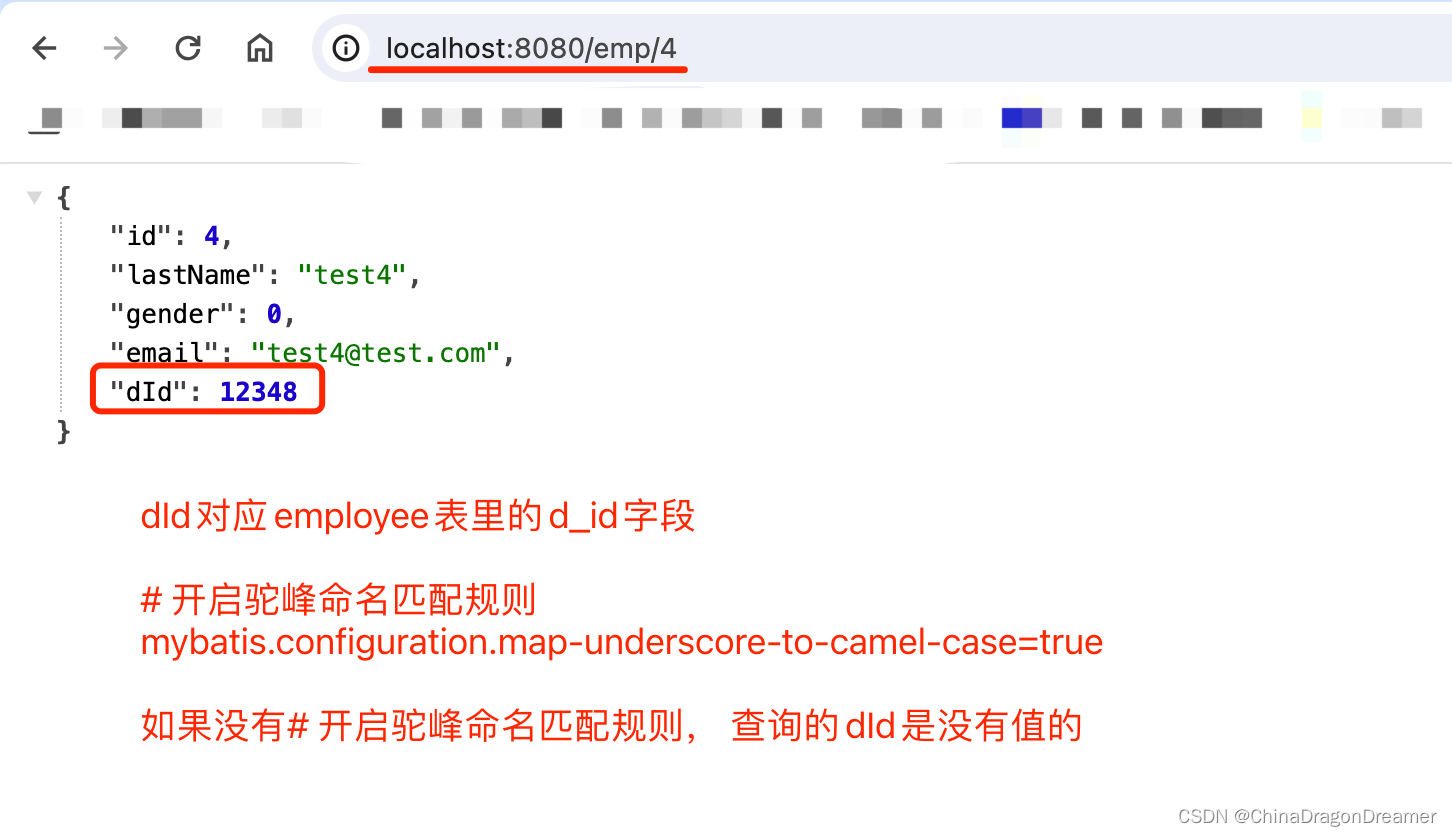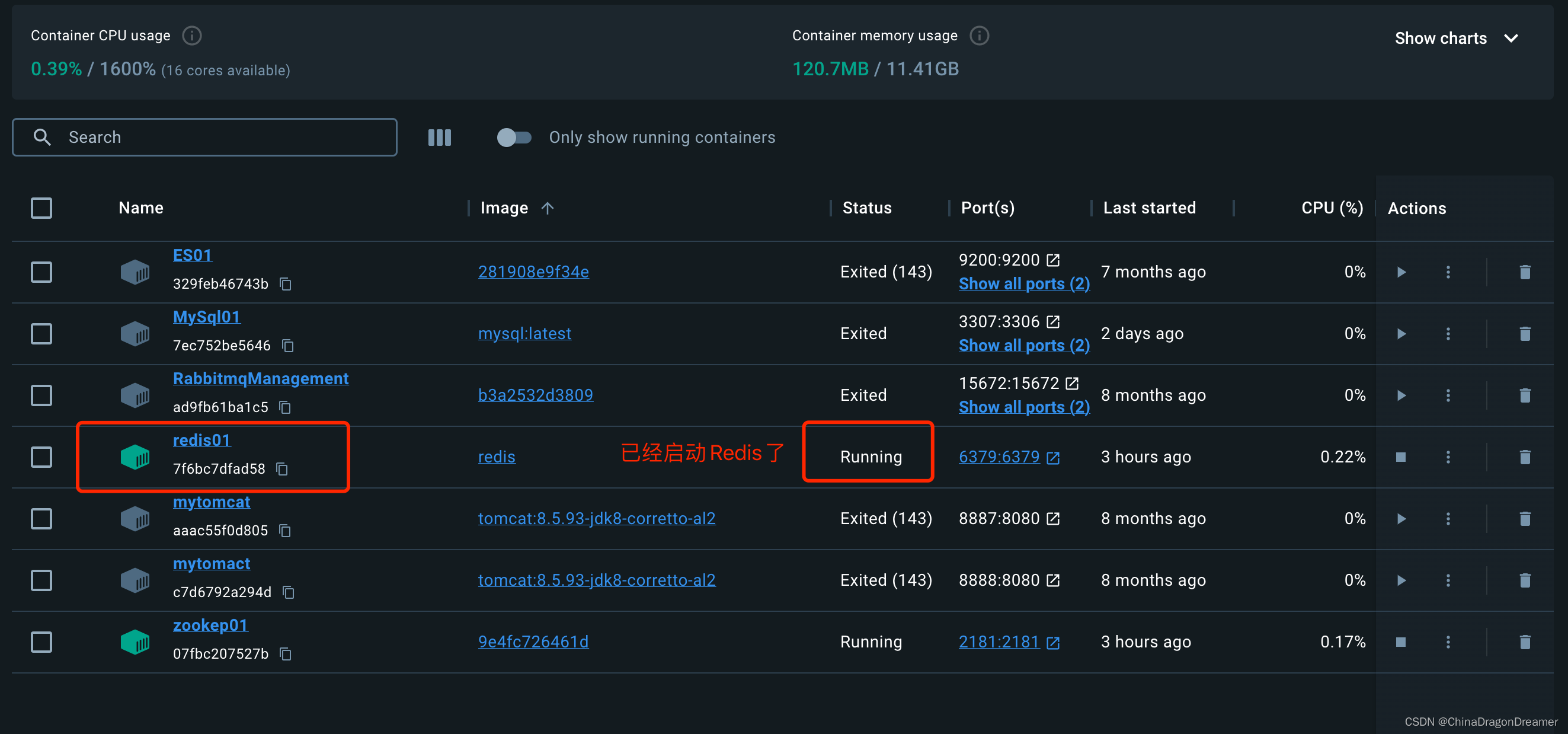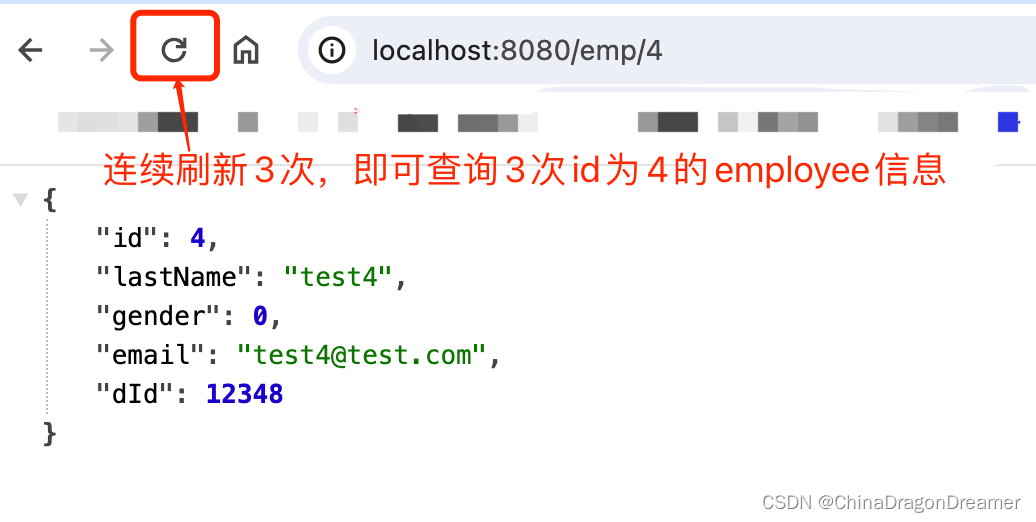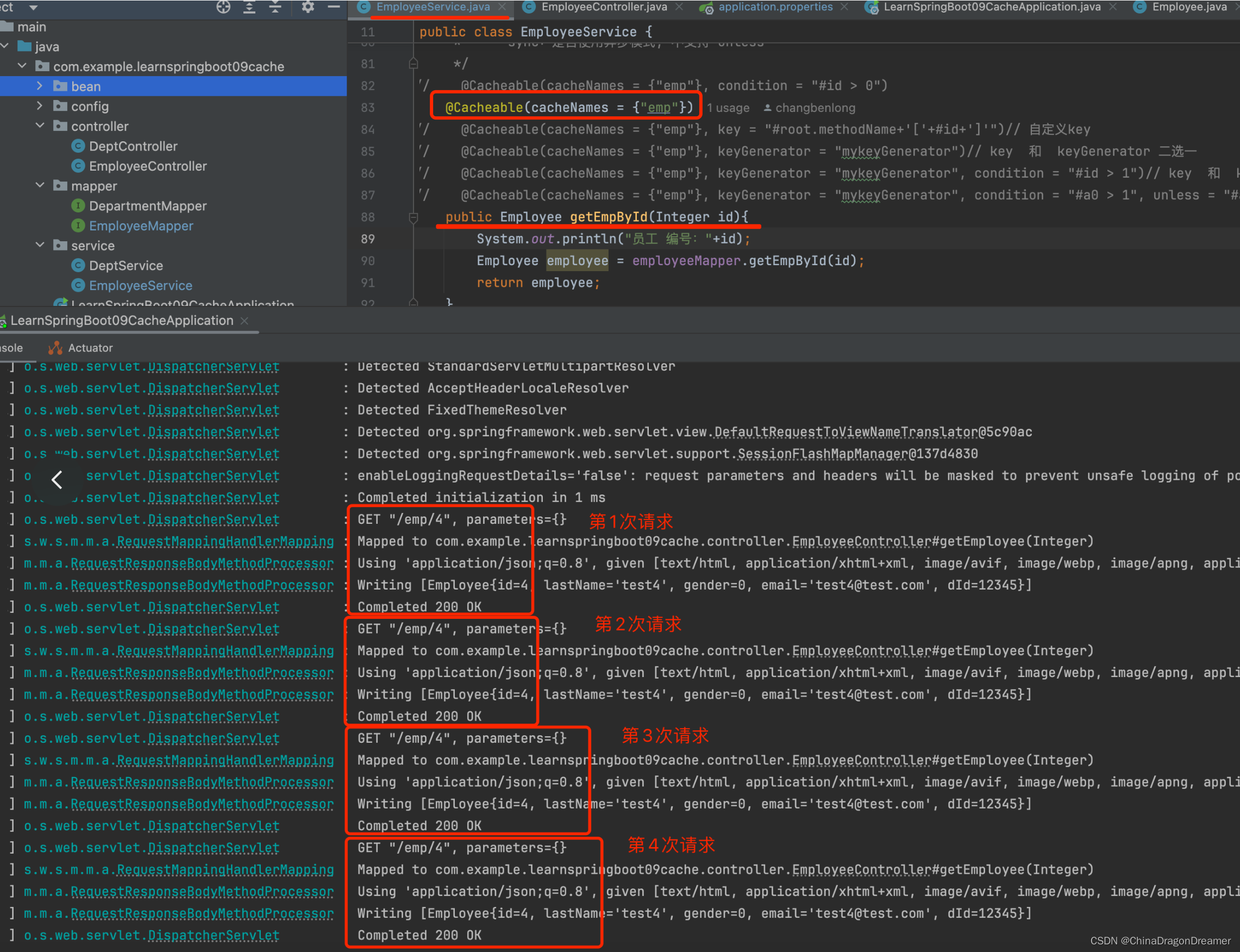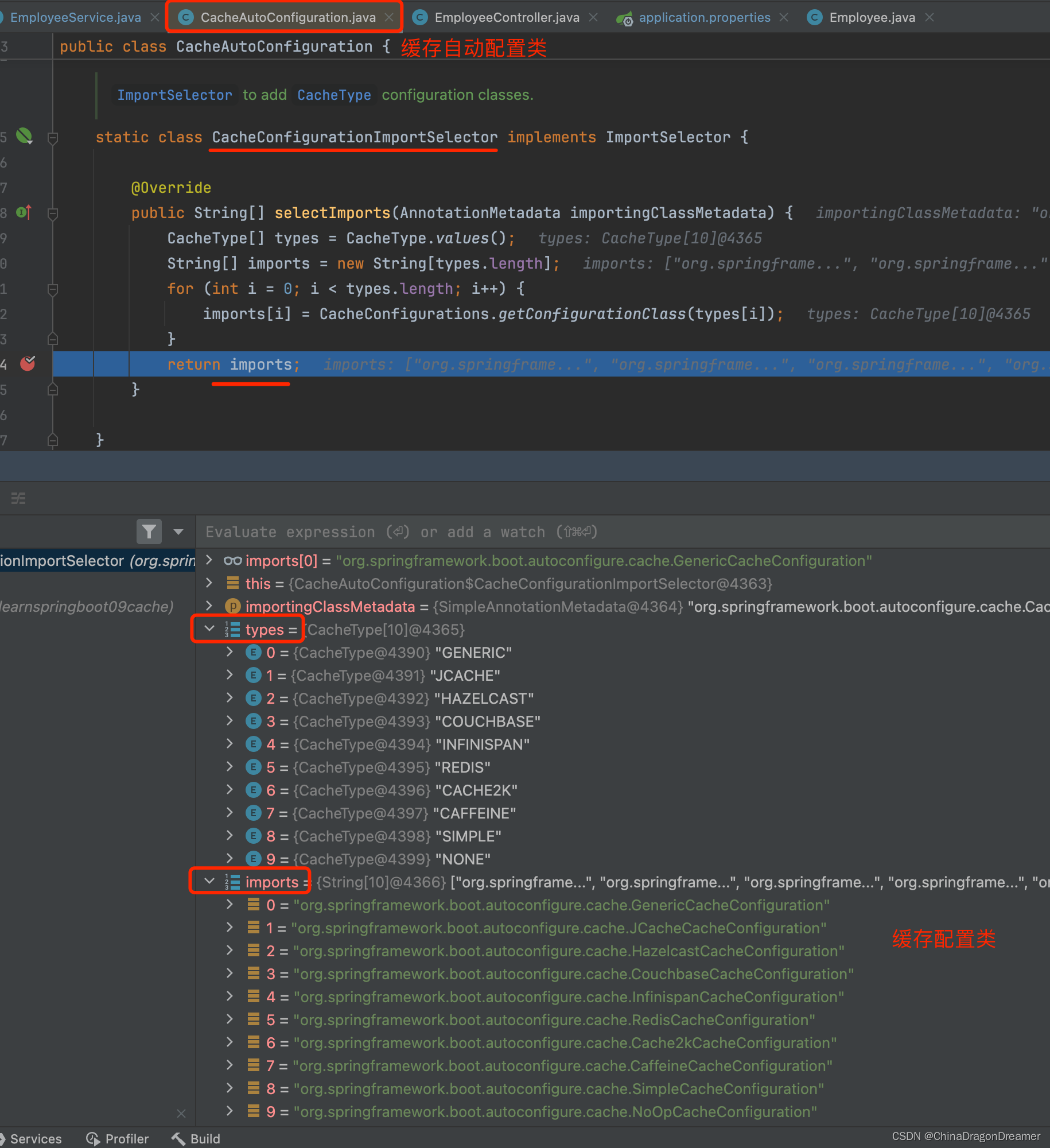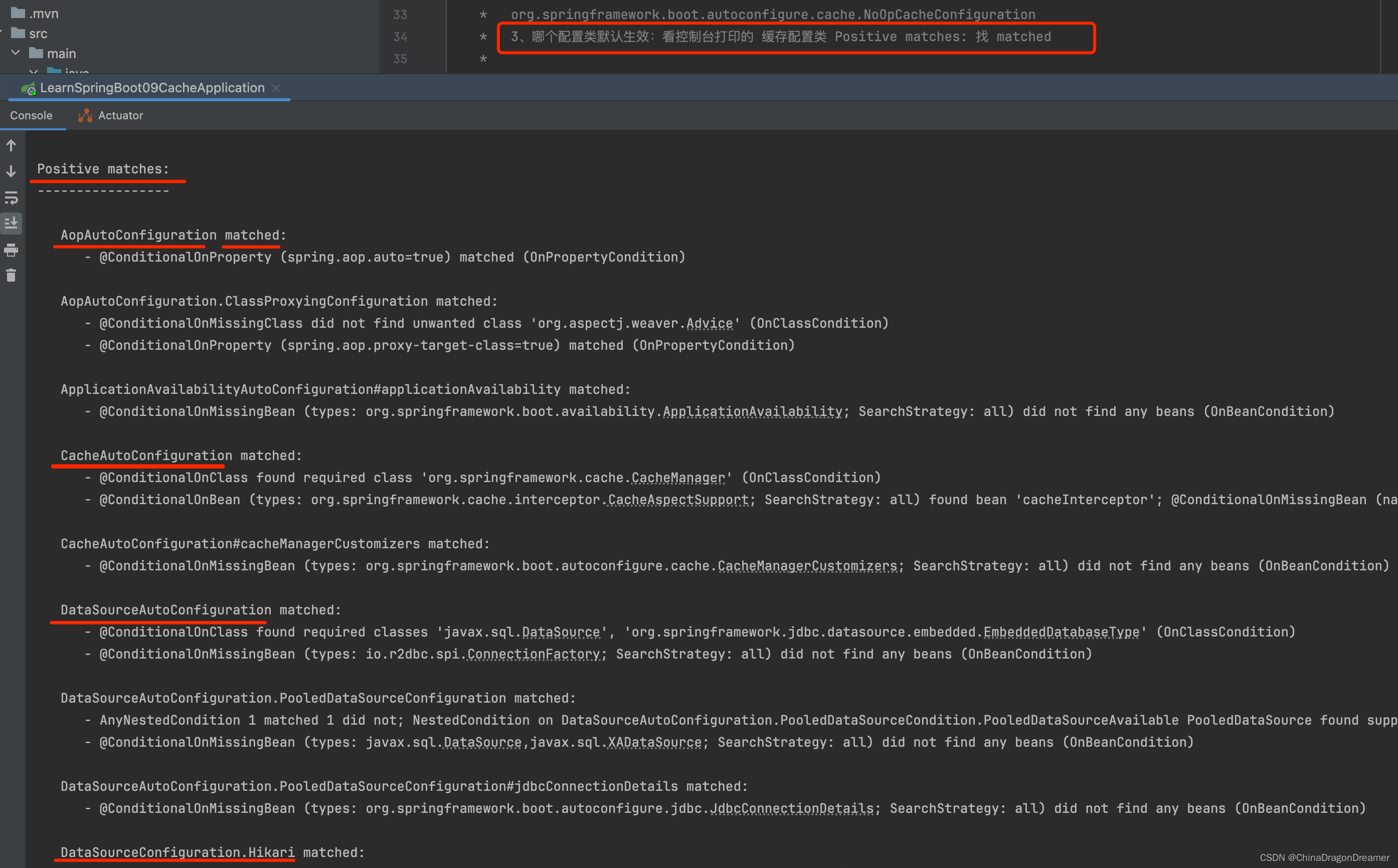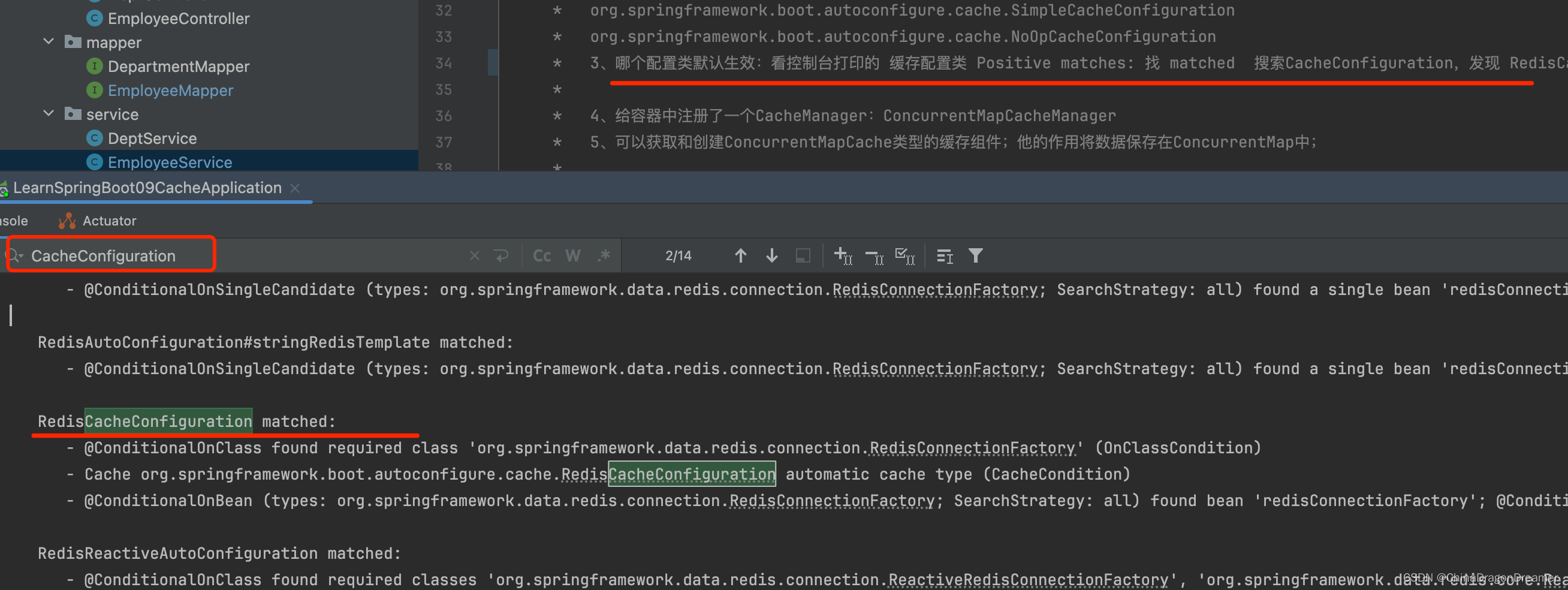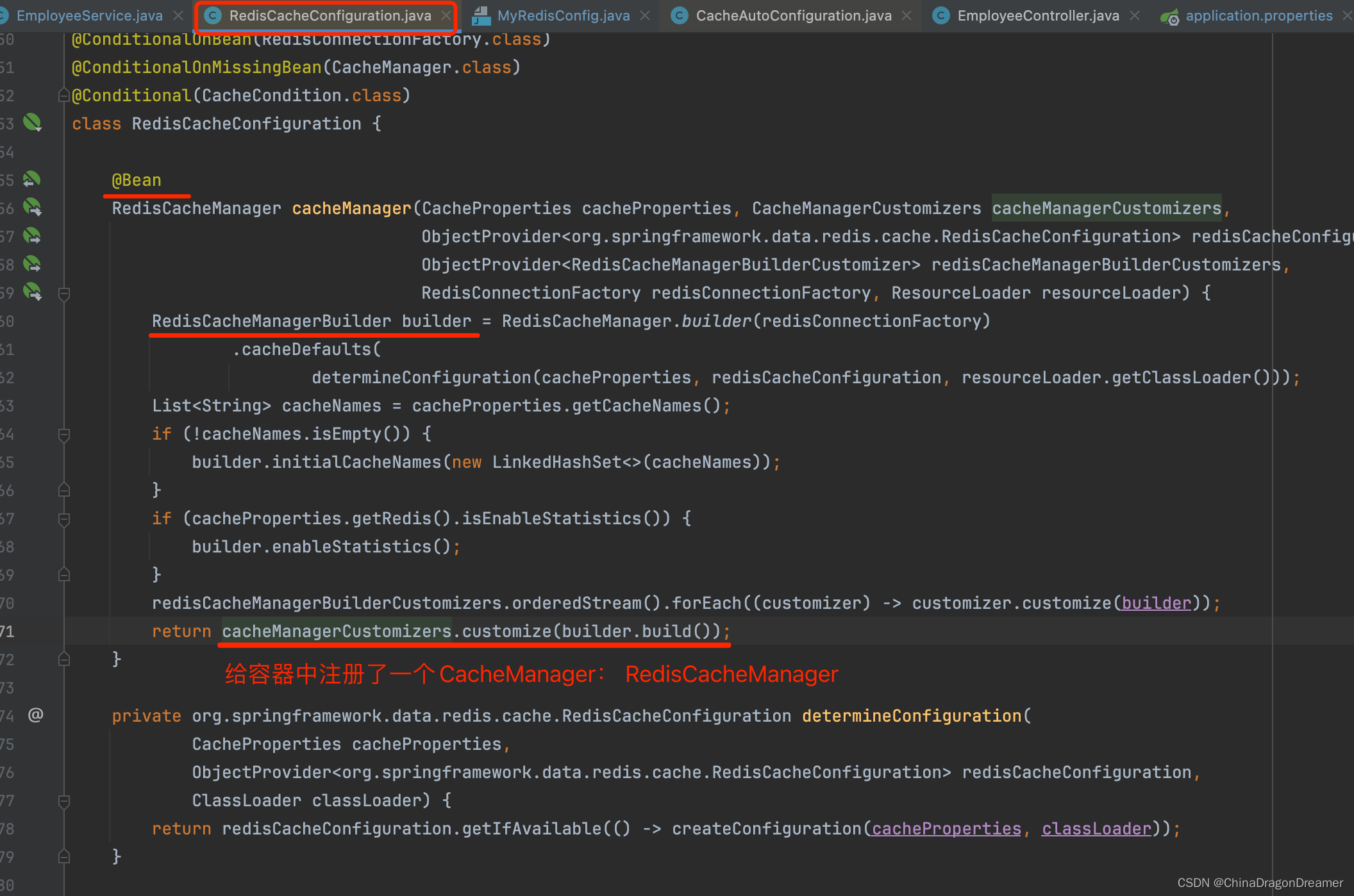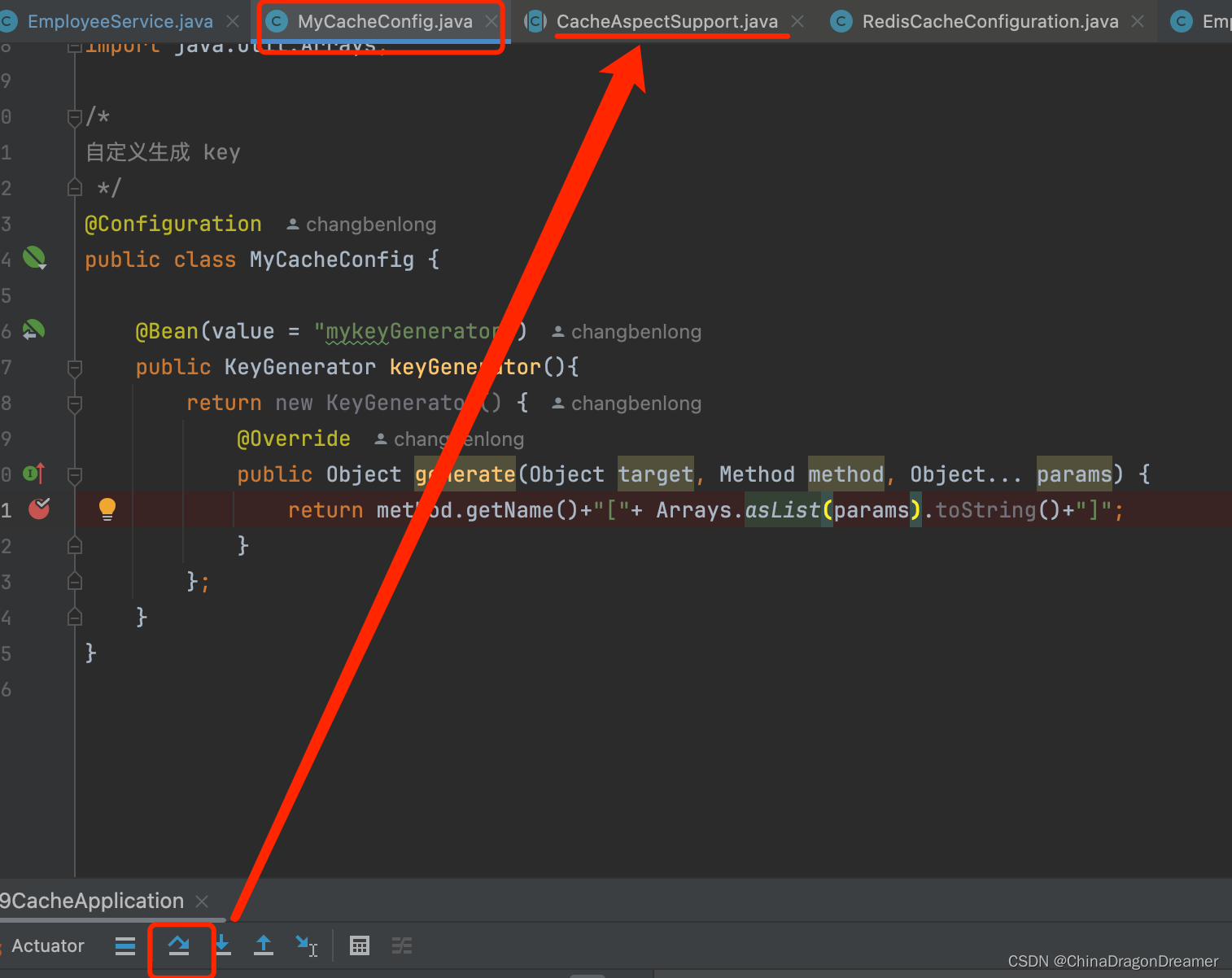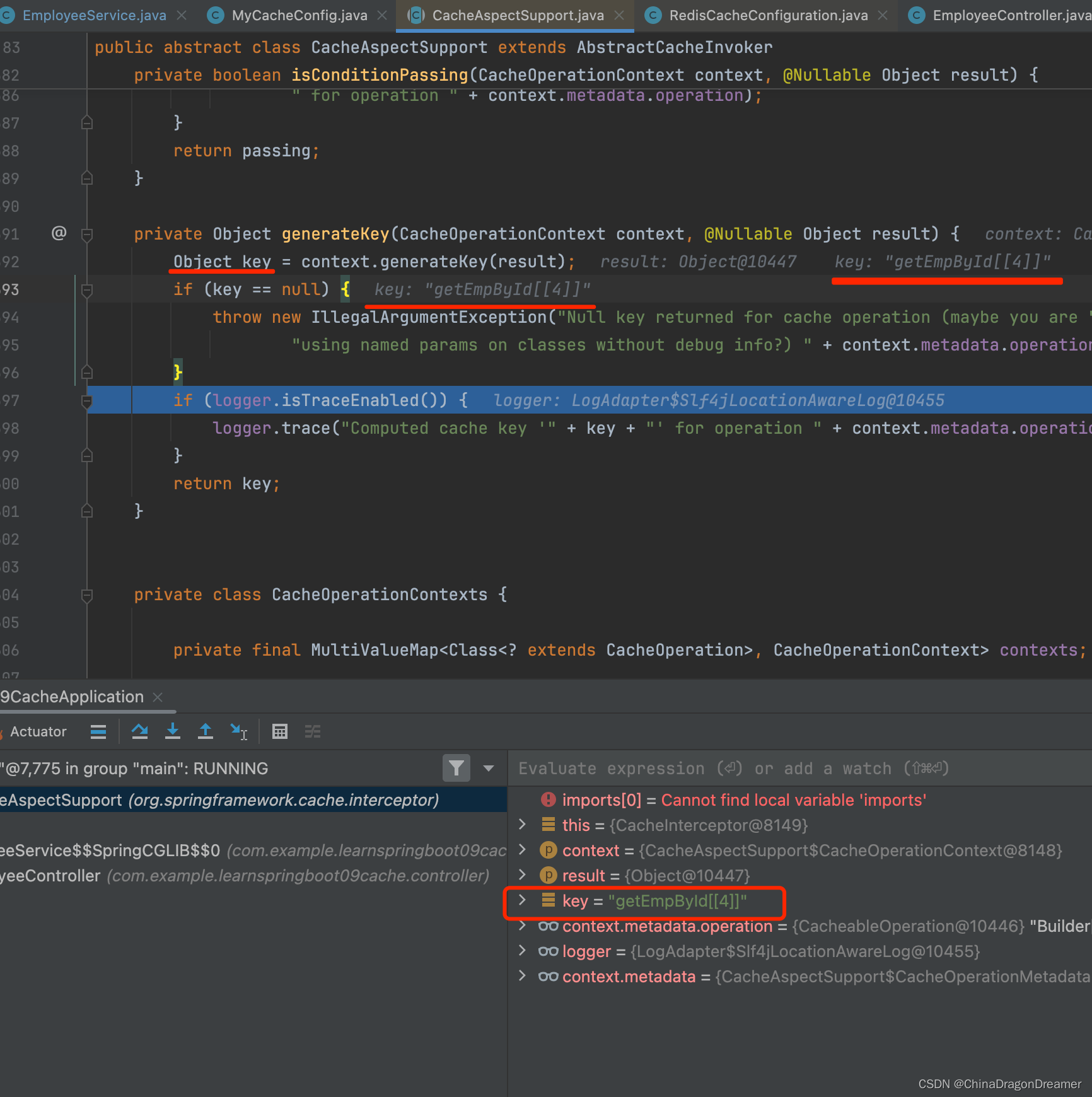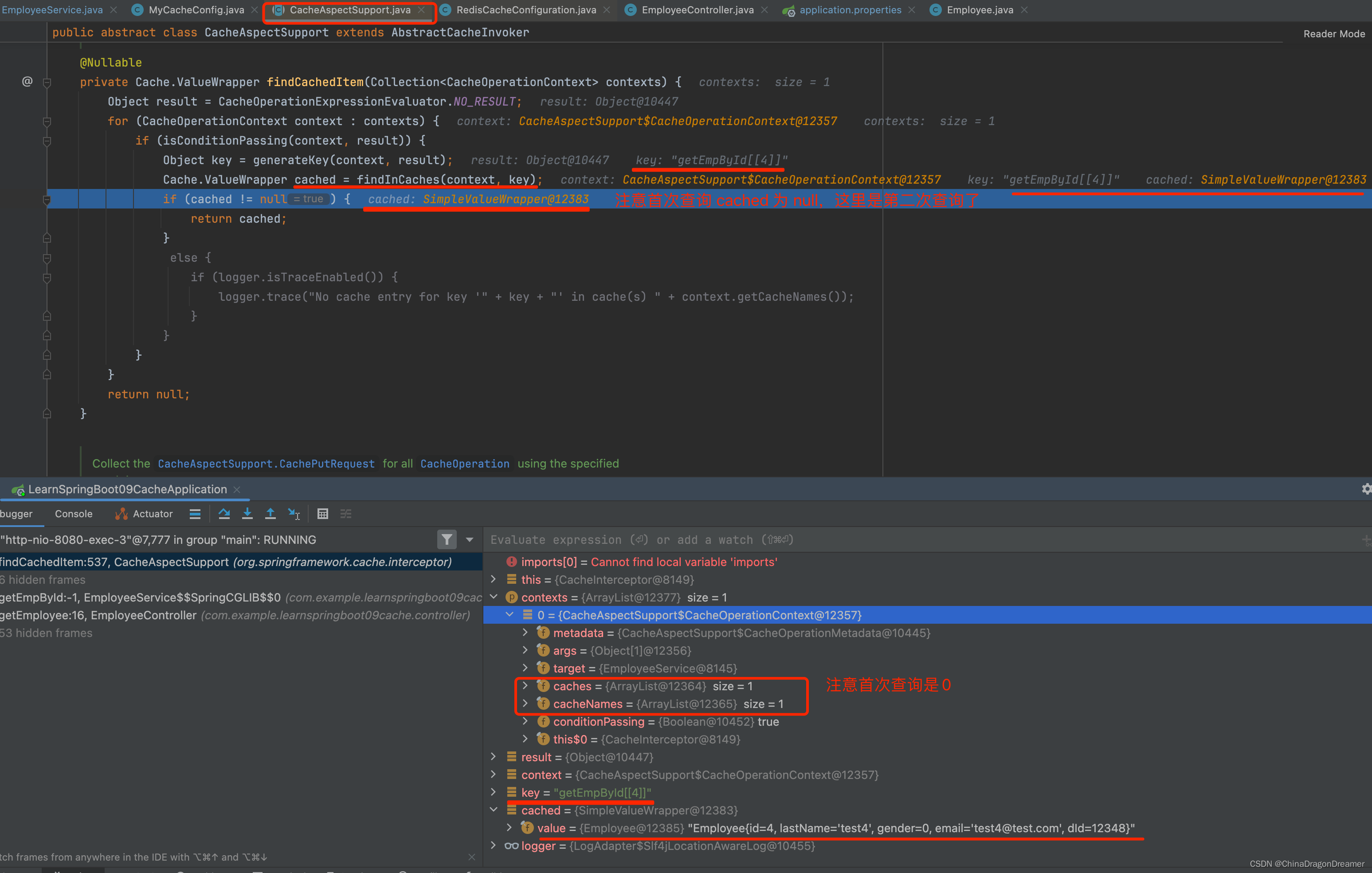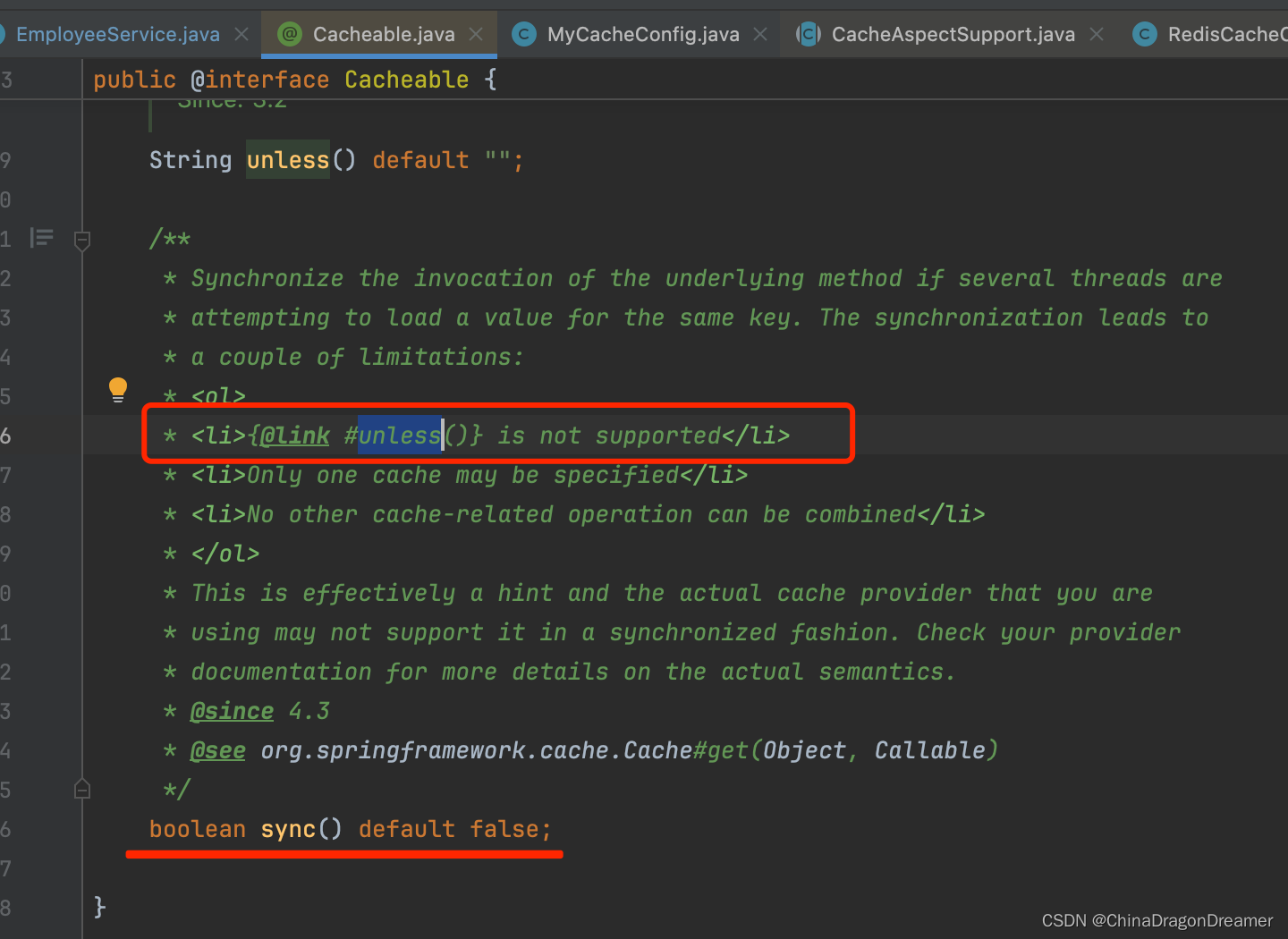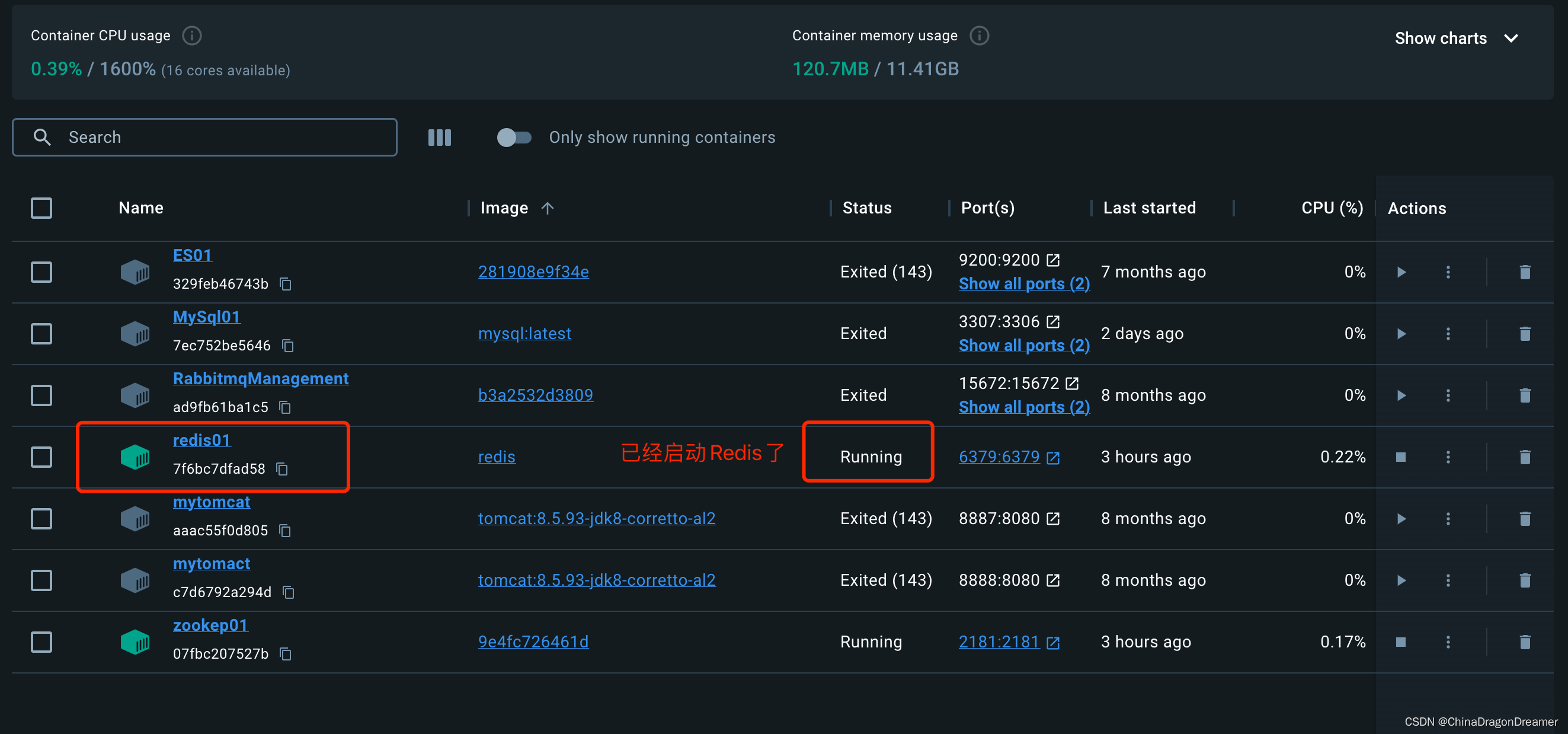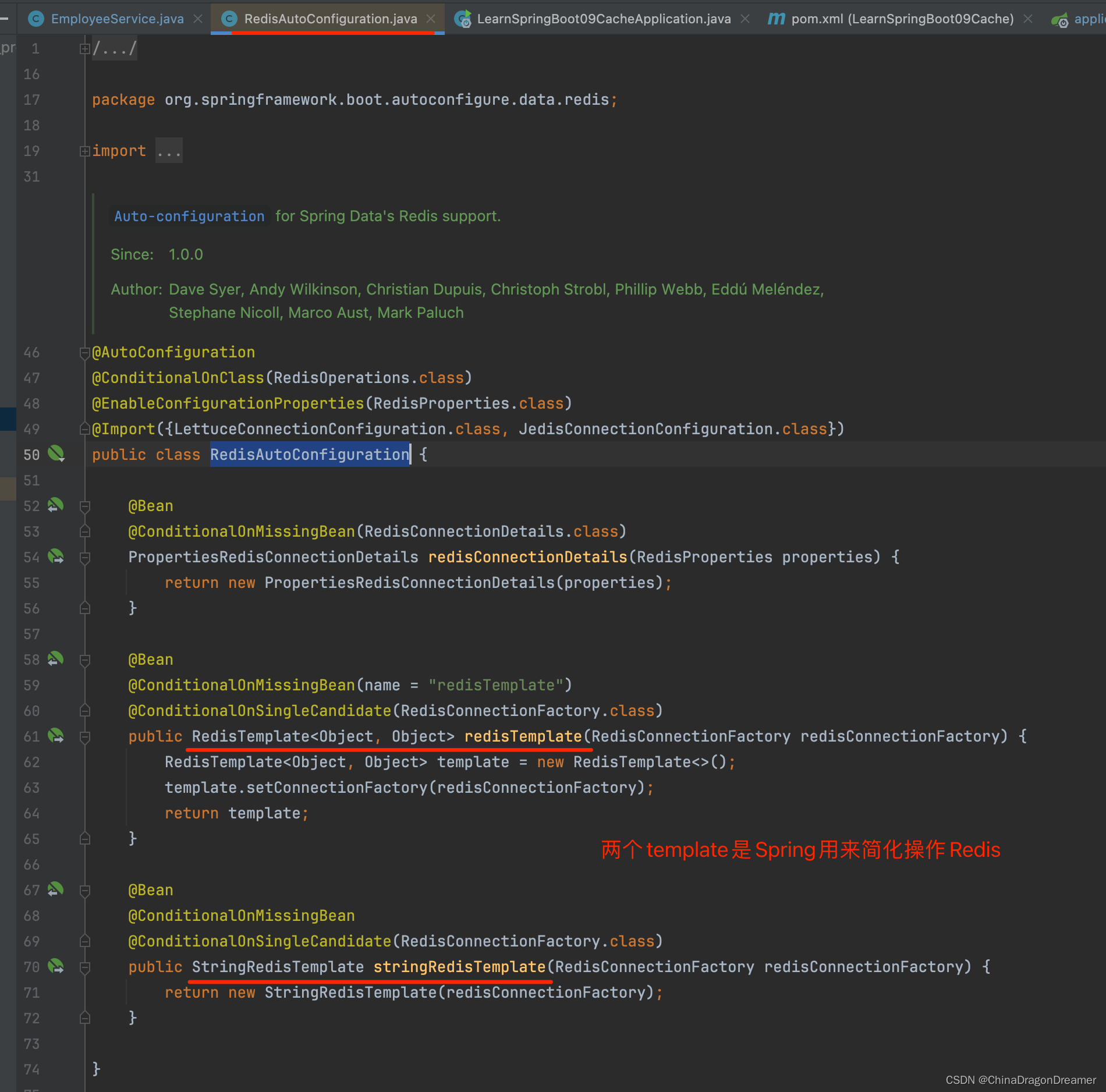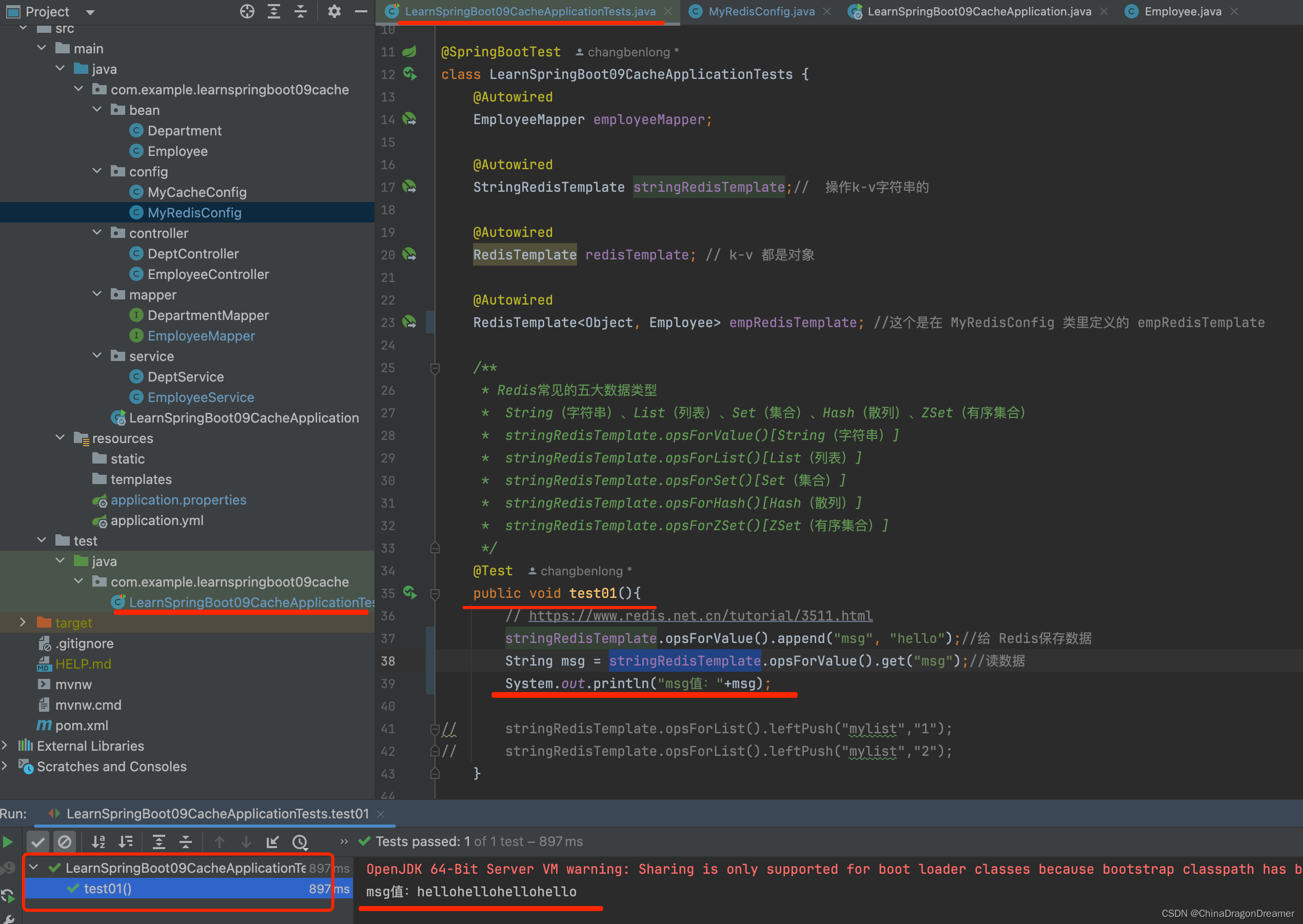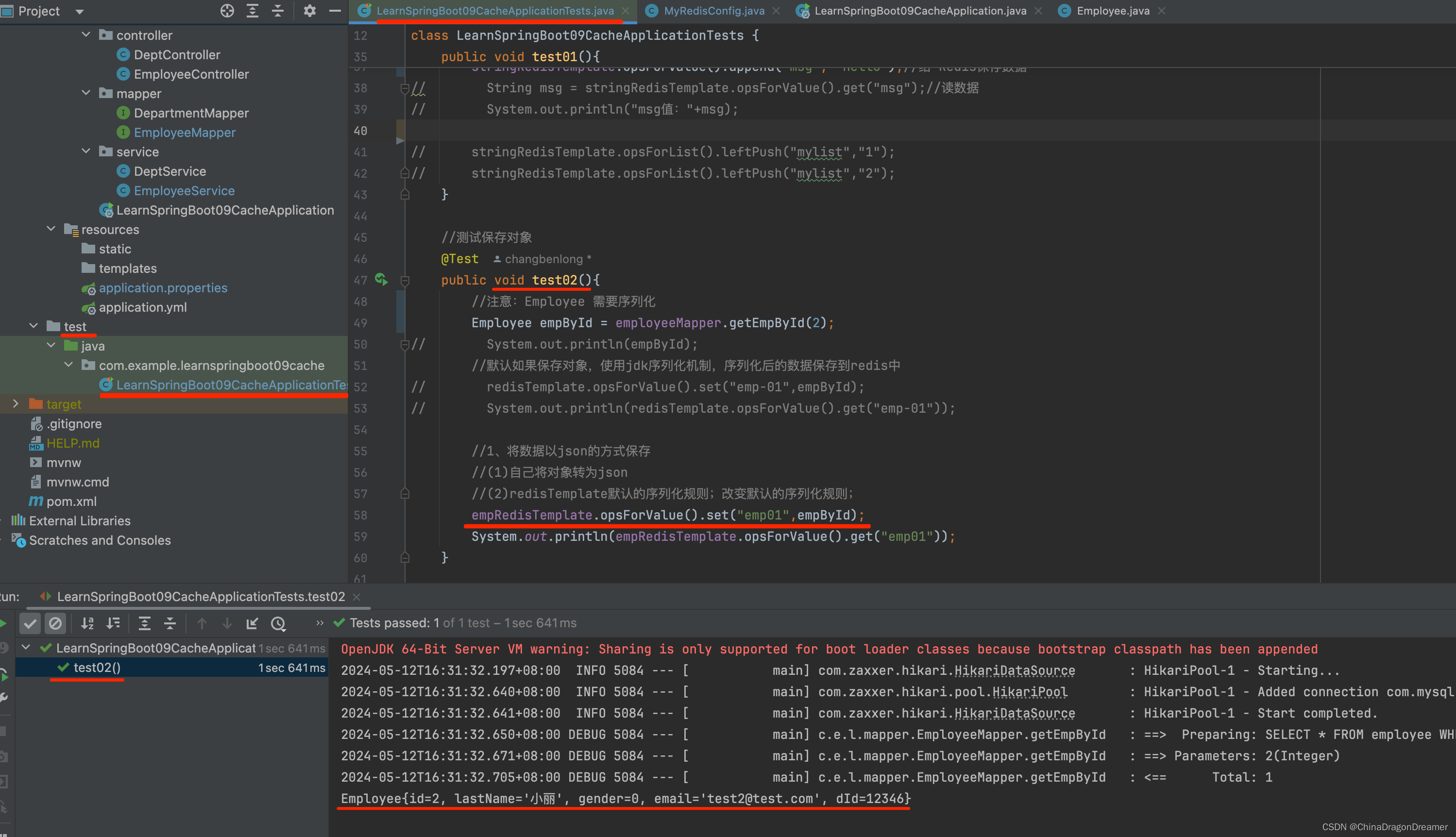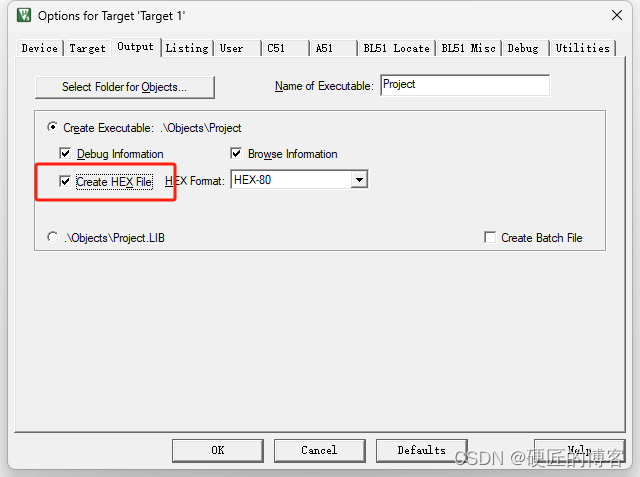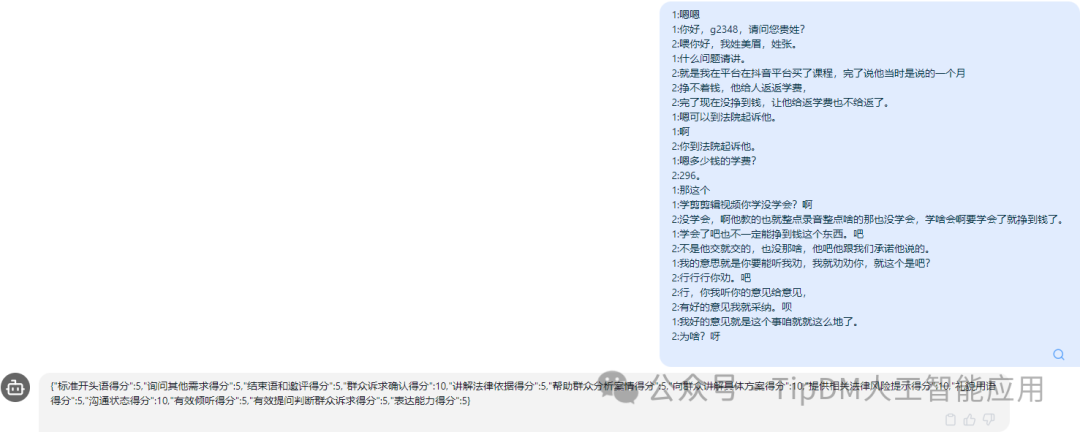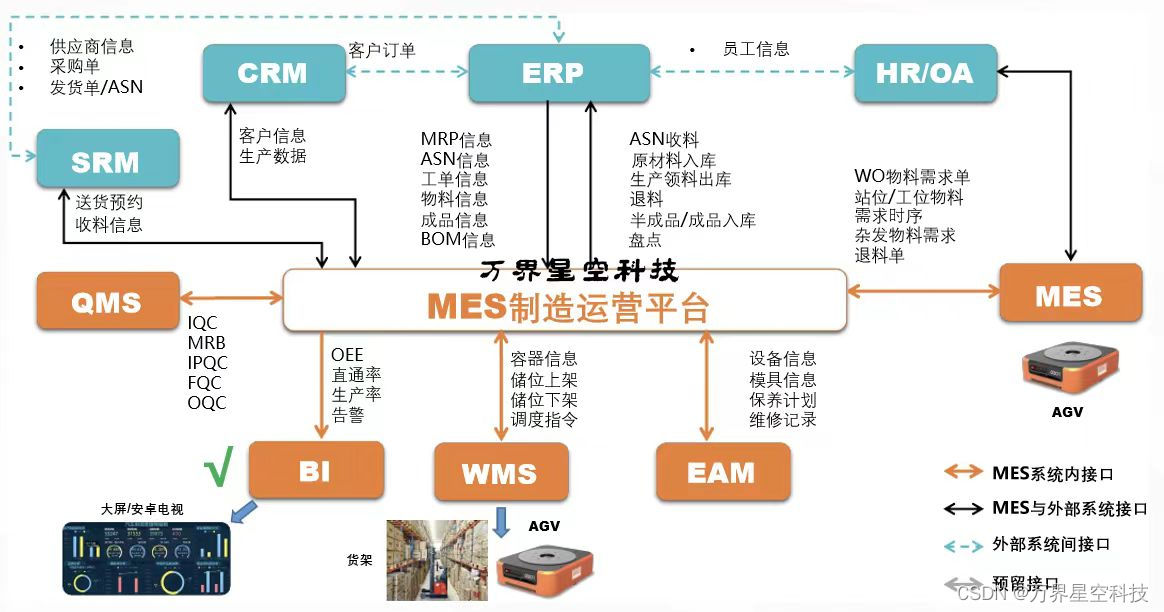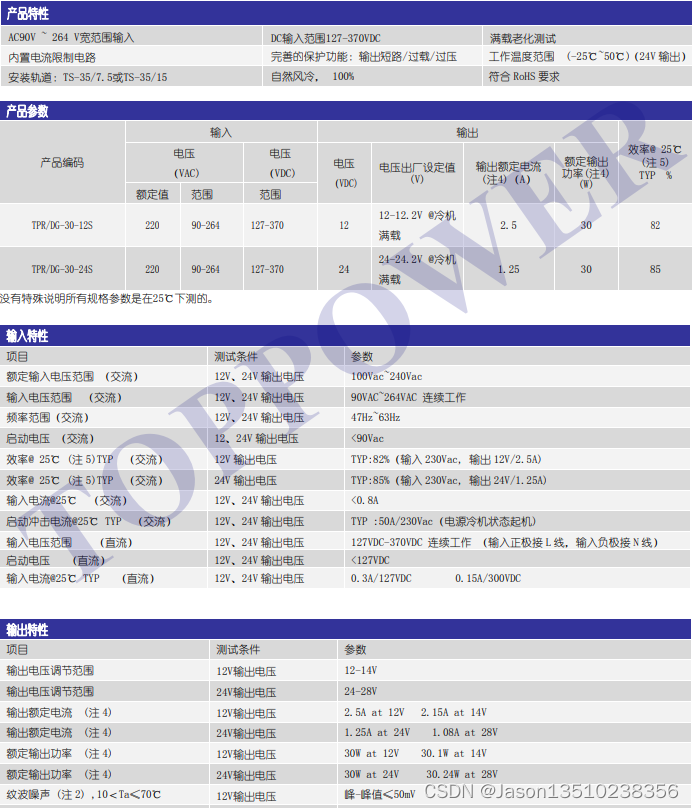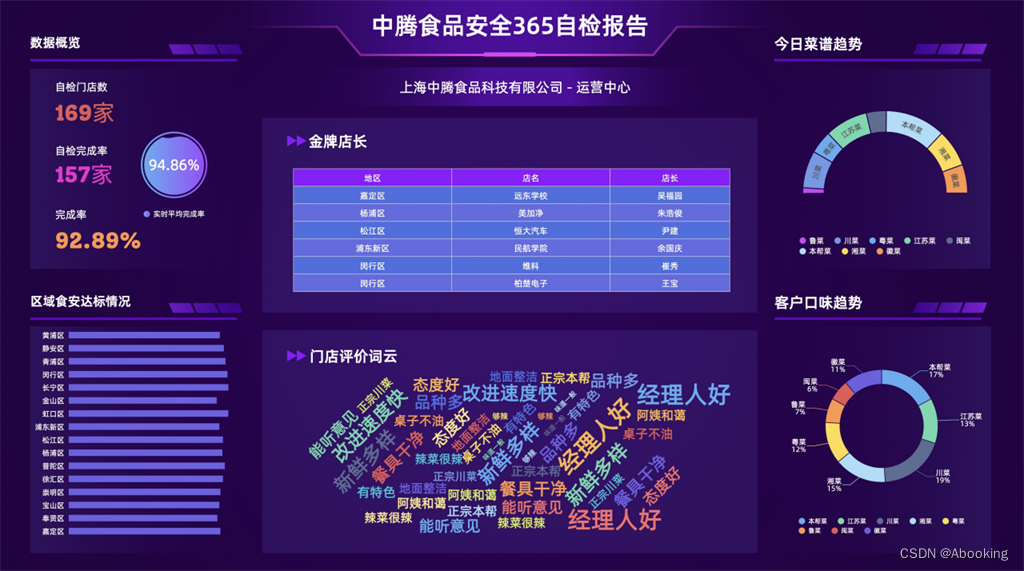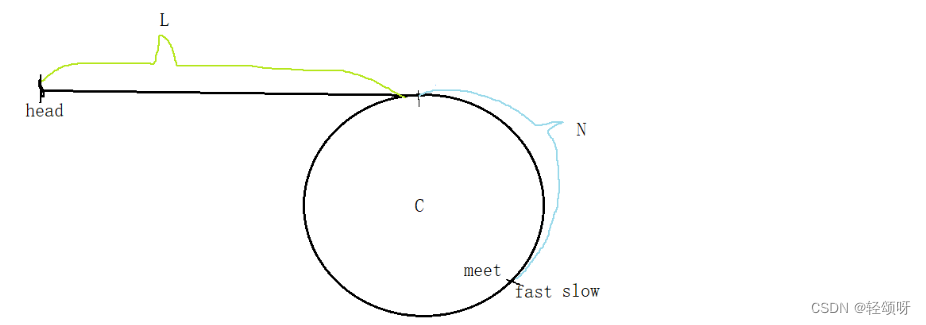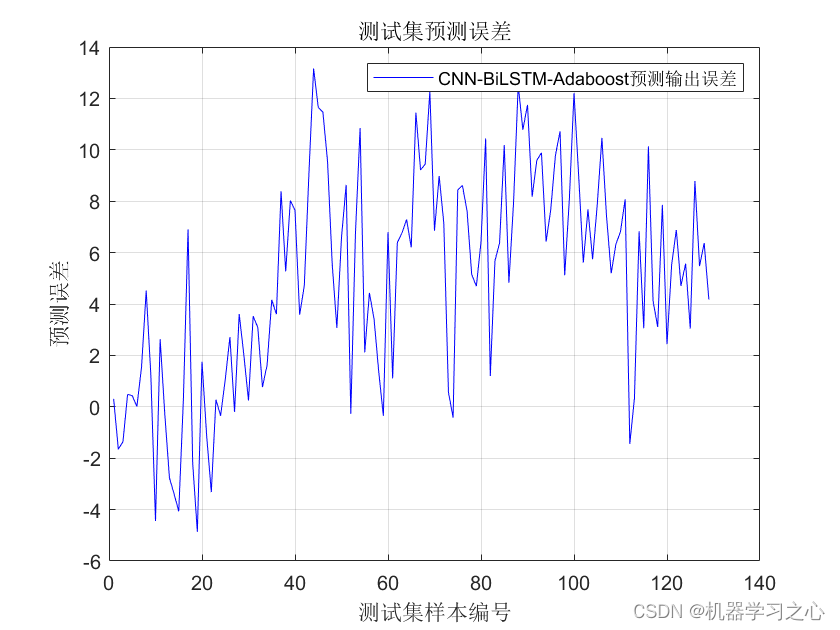点击查看SpringBoot缓存demo:LearnSpringBoot09Cache-Redis
技术摘要
- 注解版的 mybatis
- @CacheConfig
- @Cacheable
- @CachePut:既调用方法,又更新缓存数据;同步更新缓存
- @CacheEvict:缓存清除
- @Caching:定义复杂的缓存规则
- CacheManager管理多个Cache组件的,对缓存的真正CRUD操作在Cache组件中,每一个缓存组件有自己唯一一个名字;
- 搭建Redis缓存环境及测试
- RedisTemplate
- 自定义CacheManager
一、缓存抽象
二、重要的概念和缓存注解
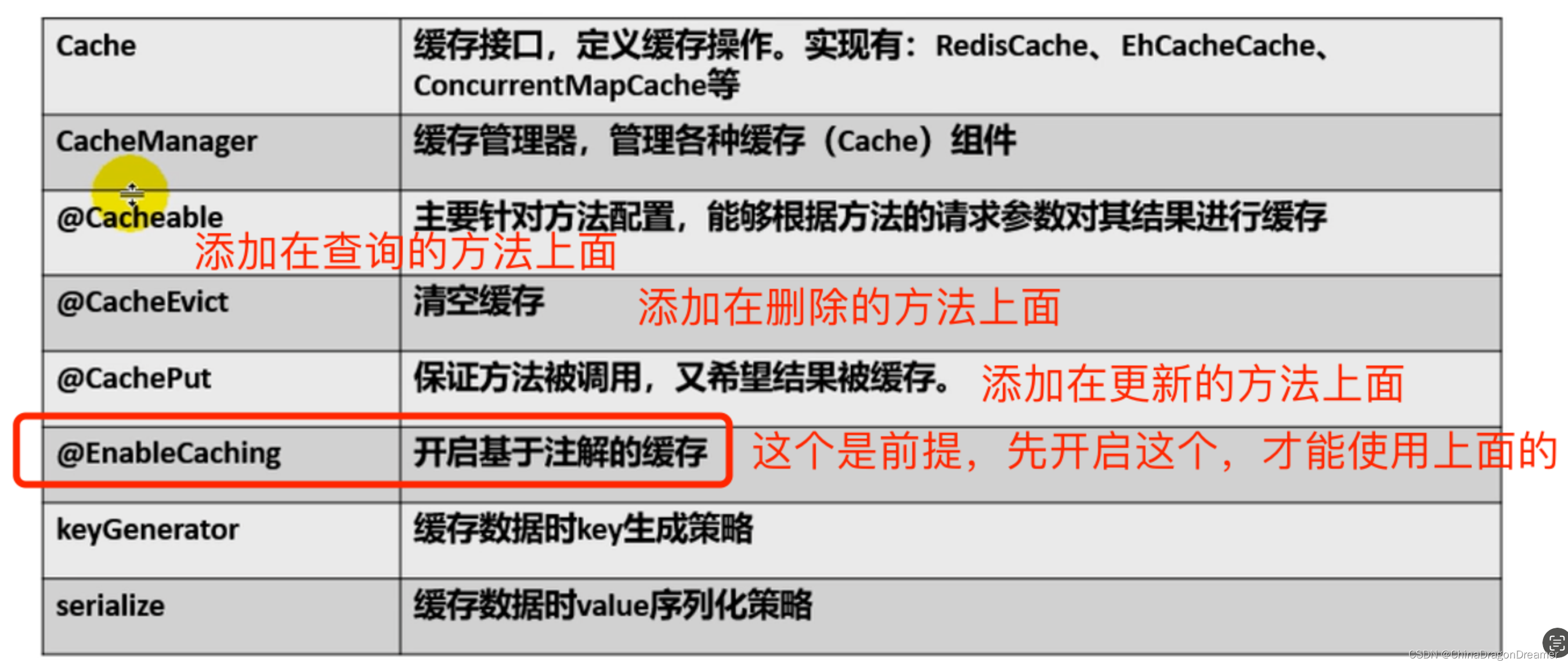
三、搭建基本环境
pom.xml代码
<?xml version="1.0" encoding="UTF-8"?>
<project xmlns="http://maven.apache.org/POM/4.0.0" xmlns:xsi="http://www.w3.org/2001/XMLSchema-instance"
xsi:schemaLocation="http://maven.apache.org/POM/4.0.0 https://maven.apache.org/xsd/maven-4.0.0.xsd">
<modelVersion>4.0.0</modelVersion>
<parent>
<groupId>org.springframework.boot</groupId>
<artifactId>spring-boot-starter-parent</artifactId>
<version>3.1.1</version>
<relativePath/> <!-- lookup parent from repository -->
</parent>
<groupId>com.example</groupId>
<artifactId>LearnSpringBoot09Cache</artifactId>
<version>0.0.1-SNAPSHOT</version>
<name>LearnSpringBoot09Cache</name>
<description>LearnSpringBoot09Cache</description>
<properties>
<java.version>17</java.version>
</properties>
<dependencies>
<!-- https://docs.spring.io/spring-boot/docs/current/reference/htmlsingle/#using.build-systems.starters -->
<dependency>
<groupId>org.springframework.boot</groupId>
<artifactId>spring-boot-starter-cache</artifactId>
</dependency>
<dependency>
<groupId>org.springframework.boot</groupId>
<artifactId>spring-boot-starter-data-redis</artifactId>
</dependency>
<!-- <dependency>-->
<!-- <groupId>org.springframework.boot</groupId>-->
<!-- <artifactId>spring-boot-starter-jdbc</artifactId>-->
<!-- </dependency>-->
<dependency>
<groupId>org.springframework.boot</groupId>
<artifactId>spring-boot-starter-web</artifactId>
</dependency>
<dependency>
<groupId>org.mybatis.spring.boot</groupId>
<artifactId>mybatis-spring-boot-starter</artifactId>
<version>3.0.2</version>
</dependency>
<dependency>
<groupId>com.mysql</groupId>
<artifactId>mysql-connector-j</artifactId>
<scope>runtime</scope>
</dependency>
<dependency>
<groupId>org.springframework.boot</groupId>
<artifactId>spring-boot-starter-test</artifactId>
<scope>test</scope>
</dependency>
<!-- <dependency>-->
<!-- <groupId>org.mybatis.spring.boot</groupId>-->
<!-- <artifactId>mybatis-spring-boot-starter</artifactId>-->
<!-- <version>3.0.2</version>-->
<!-- <scope>test</scope>-->
<!-- </dependency>-->
</dependencies>
<build>
<plugins>
<plugin>
<groupId>org.springframework.boot</groupId>
<artifactId>spring-boot-maven-plugin</artifactId>
</plugin>
</plugins>
</build>
</project>
3.1 创建出department和employee表
department表数据
employee表数据
3.2 创建javaBean封装数据
Department.java代码
package com.example.learnspringboot09cache.bean;
import java.io.Serializable;
public class Department implements Serializable {
private Integer id;
private String departmentName;
public void setId(Integer id) {
this.id = id;
}
public void setDepartmentName(String departmentName) {
this.departmentName = departmentName;
}
public Integer getId() {
return id;
}
public String getDepartmentName() {
return departmentName;
}
}
Employee.java代码
package com.example.learnspringboot09cache.bean;
import java.io.Serializable;
/*
https://blog.csdn.net/qq_26898033/article/details/129951400
*/
public class Employee implements Serializable {
private Integer id;
private String lastName;
private Integer gender;
private String email;
private Integer dId;
public void setId(Integer id) {
this.id = id;
}
public void setLastName(String lastName) {
this.lastName = lastName;
}
public void setGender(Integer gender) {
this.gender = gender;
}
public void setEmail(String email) {
this.email = email;
}
public void setdId(Integer dId) {
this.dId = dId;
}
public Integer getId() {
return id;
}
public String getLastName() {
return lastName;
}
public Integer getGender() {
return gender;
}
public String getEmail() {
return email;
}
public Integer getdId() {
return dId;
}
@Override
public String toString() {
return "Employee{" +
"id=" + id +
", lastName='" + lastName + '\'' +
", gender=" + gender +
", email='" + email + '\'' +
", dId=" + dId +
'}';
}
}
3.3 整合MyBatis操作数据库
3.3.1 配置数据源信息
application.properties配置
spring.datasource.username=root
spring.datasource.password=123456
spring.datasource.url=jdbc:mysql://192.168.0.103:3307/dbjdbc
#spring.datasource.url=jdbc:mysql://localhost:3306/springboot_cache
#spring.datasource.driver-class-name=com.mysql.cj.jdbc.Driver 可以不写,springboot自动识别驱动
# 开启驼峰命名匹配规则
mybatis.configuration.map-underscore-to-camel-case=true
#打印 mapper sql 语句
logging.level.com.example.learnspringboot09cache.mapper=debug
spring.data.redis.host=192.168.0.103
spring.data.redis.port=6379
#spring.data.redis.password=123456
# 查看控制台日志 打印自动配置相关信息,这里主页看缓存配置类
debug=true
3.3.2 使用注解版的MyBatis
@MapperScan指定需要扫描的mapper接口所在的包
LearnSpringBoot09CacheApplication.java代码
@MapperScan(value = "com.example.learnspringboot09cache.mapper")
@SpringBootApplication
@EnableCaching
public class LearnSpringBoot09CacheApplication {
public static void main(String[] args) {
SpringApplication.run(LearnSpringBoot09CacheApplication.class, args);
}
}
3.3.3 创建Mapper接口,并使用@Mapper注解
DepartmentMapper.java代码
package com.example.learnspringboot09cache.mapper;
import com.example.learnspringboot09cache.bean.Department;
import org.apache.ibatis.annotations.Mapper;
import org.apache.ibatis.annotations.Select;
@Mapper
public interface DepartmentMapper {
@Select("SELECT * FROM department WHERE id = #{id}")
Department getDeptById(Integer id);
}
EmployeeMapper.java代码
package com.example.learnspringboot09cache.mapper;
import com.example.learnspringboot09cache.bean.Employee;
import org.apache.ibatis.annotations.*;
/*
注解版的 mybatis
*/
@Mapper
public interface EmployeeMapper {
@Select("SELECT * FROM employee WHERE id = #{id}")
public Employee getEmpById(Integer id);
@Update("UPDATE employee SET lastName=#{lastName},email=#{email},gender=#{gender},d_id=#{dId} WHERE id=#{id}")
public void updateEmp(Employee employee);
@Delete("DELETE FROM employee WHERE id=#{id}")
public void deleteEmpById(Integer id);
@Insert("INSERT INTO employee(lastName,email,gender,d_id) VALUES(#{lastName},#{email},#{gender},#{dId})")
public void insertEmployee(Employee employee);
@Select("SELECT * FROM employee WHERE lastName = #{lastName}")
Employee getEmpByLastName(String lastName);
}
3.3.4 测试Mapper接口
LearnSpringBoot09CacheApplicationTests.java代码
@SpringBootTest
class LearnSpringBoot09CacheApplicationTests {
@Autowired
EmployeeMapper employeeMapper;
@Test
void contextLoads() {
Employee employee = employeeMapper.getEmpById(1);
System.out.println(employee);
}
}
测试结果
从打印结果可以看出与数据库里的employee表数据一致,说明mapper接口可用
3.3.5 在网页上测试mapper接口
创建Service
EmployeeService.java
@Service
public class EmployeeService {
@Autowired
EmployeeMapper employeeMapper;
public Employee getEmpById(Integer id){
System.out.println("员工 编号:"+id);
Employee employee = employeeMapper.getEmpById(id);
return employee;
}
}
创建Controller
EmployeeController.java
package com.example.learnspringboot09cache.controller;
import com.example.learnspringboot09cache.bean.Employee;
import com.example.learnspringboot09cache.service.EmployeeService;
import org.springframework.beans.factory.annotation.Autowired;
import org.springframework.web.bind.annotation.GetMapping;
import org.springframework.web.bind.annotation.PathVariable;
import org.springframework.web.bind.annotation.RestController;
@RestController
public class EmployeeController {
@Autowired
EmployeeService employeeService;
@GetMapping("/emp/{id}")
public Employee getEmployee(@PathVariable(value = "id") Integer id){
return employeeService.getEmpById(id);
}
@GetMapping("/emp")
public Employee update(Employee employee){
Employee emp = employeeService.updateEmp(employee);
return emp;
}
@GetMapping("/delemp")
public String deleteEmp(Integer id){
employeeService.deleteEmp(id);
return "success";
}
@GetMapping("/emp/lastname/{lastName}")
public Employee getEmpByLastName(@PathVariable("lastName") String lastName){
return employeeService.getEmpByLastName(lastName);
}
}
使用@PathVariable取路径变量
测试结果
在application.properties配置文件里,开启驼峰命名匹配规则
mybatis.configuration.map-underscore-to-camel-case=true
四、快速体验缓存
提醒:先安装Redis,示例使用docker安装Redis,如果下图
- 开启基于注解的缓存 @EnableCaching
- 标注缓存注解即可
@Cacheable
@CacheEvict
@CachePut默认使用的是ConcurrentMapCacheManager==ConcurrentMapCache;将数据保存在 ConcurrentMap<Object, Object>中
开发中使用缓存中间件;redis、memcached、ehcache;
4.1.1未开启缓存时,每次查询数据都需要访问数据库
验证
在application.properties配置文件里添加打印 mapper sql 语句
#打印 mapper sql 语句
logging.level.com.example.learnspringboot09cache.mapper=debug
在浏览器里访问http://localhost:8080/emp/4
看控制台查询结果已经打印的SQL日志
从控制台打印的日志可以看到,每次请求都发送了SQL语句,即每次都从数据库里查询
4.1.2 使用@Cacheable开启缓存
提醒:需要先启动Redis,否则运行项目后查询失败,因为连接redis失败
EmployeeService.java代码
@Service
public class EmployeeService {
@Autowired
EmployeeMapper employeeMapper;
/*
* 将方法的运行结果进行缓存;以后再要相同的数据,直接从缓存中获取,不用调用方法;
* CacheManager管理多个Cache组件的,对缓存的真正CRUD操作在Cache组件中,每一个缓存组件有自己唯一一个名字;
* *
* 原理:
* 1、自动配置类;CacheAutoConfiguration
* CacheConfigurationImportSelector selectImports 方法返回的配置类如下
* 2、缓存的配置类
* org.springframework.boot.autoconfigure.cache.GenericCacheConfiguration
* org.springframework.boot.autoconfigure.cache.JCacheCacheConfiguration
* org.springframework.boot.autoconfigure.cache.EhCacheCacheConfiguration
* org.springframework.boot.autoconfigure.cache.HazelcastCacheConfiguration
* org.springframework.boot.autoconfigure.cache.InfinispanCacheConfiguration
* org.springframework.boot.autoconfigure.cache.CouchbaseCacheConfiguration
* org.springframework.boot.autoconfigure.cache.RedisCacheConfiguration
* org.springframework.boot.autoconfigure.cache.CaffeineCacheConfiguration
* org.springframework.boot.autoconfigure.cache.GuavaCacheConfiguration
* org.springframework.boot.autoconfigure.cache.SimpleCacheConfiguration
* org.springframework.boot.autoconfigure.cache.NoOpCacheConfiguration
* 3、哪个配置类默认生效:看控制台打印的 缓存配置类 Positive matches: 找 matched
*
* 4、给容器中注册了一个CacheManager:ConcurrentMapCacheManager
* 5、可以获取和创建ConcurrentMapCache类型的缓存组件;他的作用将数据保存在ConcurrentMap中;
*
* 运行流程:
* @Cacheable:
* 1、方法运行之前,先去查询Cache(缓存组件),按照cacheNames指定的名字获取;
* (CacheManager先获取相应的缓存),第一次获取缓存如果没有Cache组件会自动创建。
* 2、去Cache中查找缓存的内容,使用一个key,默认就是方法的参数;
* key是按照某种策略生成的;默认是使用keyGenerator生成的,默认使用SimpleKeyGenerator生成key;
* SimpleKeyGenerator生成key的默认策略;
* 如果没有参数;key=new SimpleKey();
* 如果有一个参数:key=参数的值
* 如果有多个参数:key=new SimpleKey(params);
* 3、没有查到缓存就调用目标方法;
* 4、将目标方法返回的结果,放进缓存中
*
* @Cacheable标注的方法执行之前先来检查缓存中有没有这个数据,默认按照参数的值作为key去查询缓存,
* 如果没有就运行方法并将结果放入缓存;以后再来调用就可以直接使用缓存中的数据;
*
* 核心:
* 1)、使用CacheManager【ConcurrentMapCacheManager】按照名字得到Cache【ConcurrentMapCache】组件
* 2)、key使用keyGenerator生成的,默认是SimpleKeyGenerator
*
*
* 几个属性:
* cacheNames/value:指定缓存组件的名字;将方法的返回结果放在哪个缓存中,是数组的方式,可以指定多个缓存;
*
* key:缓存数据使用的key;可以用它来指定。默认是使用方法参数的值 1-方法的返回值
* 编写SpEL; #i d;参数id的值 #a0 #p0 #root.args[0]
* getEmp[2]
*
* keyGenerator:key的生成器;可以自己指定key的生成器的组件id
* key/keyGenerator:二选一使用;
*
*
* cacheManager:指定缓存管理器;或者cacheResolver指定获取解析器
*
* condition:指定符合条件的情况下才缓存;
* ,condition = "#id>0"
* condition = "#a0>1":第一个参数的值》1的时候才进行缓存
*
* unless:否定缓存;当unless指定的条件为true,方法的返回值就不会被缓存;可以获取到结果进行判断
* unless = "#result == null"
* unless = "#a0==2":如果第一个参数的值是2,结果不缓存;
* sync:是否使用异步模式, 不支持 unless
*/
// @Cacheable(cacheNames = {"emp"}, condition = "#id > 0")
@Cacheable(cacheNames = {"emp"})
// @Cacheable(cacheNames = {"emp"}, key = "#root.methodName+'['+#id+']'")// 自定义key
// @Cacheable(cacheNames = {"emp"}, keyGenerator = "mykeyGenerator")// key 和 keyGenerator 二选一
// @Cacheable(cacheNames = {"emp"}, keyGenerator = "mykeyGenerator", condition = "#id > 1")// key 和 keyGenerator 二选一
// @Cacheable(cacheNames = {"emp"}, keyGenerator = "mykeyGenerator", condition = "#a0 > 1", unless = "#a0 == 2")// key 和 keyGenerator 二选一
public Employee getEmpById(Integer id){
System.out.println("员工 编号:"+id);
Employee employee = employeeMapper.getEmpById(id);
return employee;
}
}
控制台日志
从控制台打印的日志可以看到,每次请求不再发送SQL语句了,即不再查询数据库了,说明缓存生效了
4.1.3 原理
自动配置类;CacheAutoConfiguration
查看内部类CacheConfigurationImportSelector,里面有 selectImports 方法返回的配置类如下:2 缓存的配置类
缓存的配置类
org.springframework.boot.autoconfigure.cache.GenericCacheConfiguration
org.springframework.boot.autoconfigure.cache.JCacheCacheConfiguration
org.springframework.boot.autoconfigure.cache.EhCacheCacheConfiguration
org.springframework.boot.autoconfigure.cache.HazelcastCacheConfiguration
org.springframework.boot.autoconfigure.cache.InfinispanCacheConfiguration
org.springframework.boot.autoconfigure.cache.CouchbaseCacheConfiguration
org.springframework.boot.autoconfigure.cache.RedisCacheConfiguration
org.springframework.boot.autoconfigure.cache.CaffeineCacheConfiguration
org.springframework.boot.autoconfigure.cache.GuavaCacheConfiguration
org.springframework.boot.autoconfigure.cache.SimpleCacheConfiguration
org.springframework.boot.autoconfigure.cache.NoOpCacheConfiguration
哪个配置类默认生效:看控制台打印的 缓存配置类 Positive matches: 找 matched,搜索CacheConfiguration,发现 RedisCacheConfiguration 在matched里
** 注意:pom.xml里引入Redis之后 ,RedisCacheConfiguration, 默认的是 SimpleCacheConfiguration**
提醒:在application.properties配置文件里添加 debug=true
给容器中注册了一个CacheManager:ConcurrentMapCacheManager
注意:引入Redis之后,注册的是 RedisCacheManager
可以获取和创建CacheNames类型的缓存组件;他的作用将数据保存在ConcurrentMap中;
4.1.4 运行流程
运行流程:
@Cacheable:
- 方法运行之前,先去查询Cache(缓存组件),按照cacheNames指定的名字获取;
CacheManager先获取相应的缓存),第一次获取缓存如果没有Cache组件会自动创建。- 去Cache中查找缓存的内容,使用一个key,默认就是方法的参数;
key是按照某种策略生成的;默认是使用keyGenerator生成的,默认使用SimpleKeyGenerator生成key;
SimpleKeyGenerator生成key的默认策略;
如果没有参数;key=new SimpleKey();
如果有一个参数:key=参数的值
如果有多个参数:key=new SimpleKey(params);- 没有查到缓存就调用目标方法;
- 将目标方法返回的结果,放进缓存中
@Cacheable标注的方法执行之前先来检查缓存中有没有这个数据,默认按照参数的值作为key去查询缓存,
如果没有就运行方法并将结果放入缓存;以后再来调用就可以直接使用缓存中的数据;
核心:
- 使用CacheManager【ConcurrentMapCacheManager】按照名字得到Cache【ConcurrentMapCache】组件
- key使用keyGenerator生成的,默认是SimpleKeyGenerator
4.1.5 几个属性
cacheNames/value:指定缓存组件的名字;将方法的返回结果放在哪个缓存中,是数组的方式,可以指定多个缓存;
key:缓存数据使用的key;可以用它来指定。默认是使用方法参数的值 1-方法的返回值
编写SpEL; #i d;参数id的值 #a0 #p0 #root.args[0]
getEmp[2]
keyGenerator:key的生成器;可以自己指定key的生成器的组件id
key/keyGenerator:二选一使用;
cacheManager:指定缓存管理器;或者cacheResolver指定获取解析器
condition:指定符合条件的情况下才缓存;
condition = “#id>0”
condition = “#a0>1”:第一个参数的值 大于1的时候才进行缓存
unless:否定缓存;当unless指定的条件为true,方法的返回值就不会被缓存;可以获取到结果进行判断
unless = “#result == null”
unless = “#a0==2”:如果第一个参数的值是2,结果不缓存;
sync:是否使用异步模式, 不支持 unless
1. 自定义key
@Cacheable(cacheNames = {"emp"}, key = "#root.methodName+'['+#id+']'")
public Employee getEmpById(Integer id){
System.out.println("员工 编号:"+id);
Employee employee = employeeMapper.getEmpById(id);
return employee;
}
2. 使用keyGenerator
注意:key 和 keyGenerator 是二选一,不同同时使用
@Cacheable(cacheNames = {"emp"}, keyGenerator = "mykeyGenerator")// key 和 keyGenerator 二选一
public Employee getEmpById(Integer id){
System.out.println("员工 编号:"+id);
Employee employee = employeeMapper.getEmpById(id);
return employee;
}
自定义生成 key
MyCacheConfig.java代码
package com.example.learnspringboot09cache.config;
import org.springframework.cache.interceptor.KeyGenerator;
import org.springframework.context.annotation.Bean;
import org.springframework.context.annotation.Configuration;
import java.lang.reflect.Method;
import java.util.Arrays;
/*
自定义生成 key
*/
@Configuration
public class MyCacheConfig {
@Bean(value = "mykeyGenerator")
public KeyGenerator keyGenerator(){
return new KeyGenerator() {
@Override
public Object generate(Object target, Method method, Object... params) {
return method.getName()+"["+ Arrays.asList(params).toString()+"]";
}
};
}
}
Debug运行项目
3. condition:指定符合条件的情况下才缓存;
@Cacheable(cacheNames = {"emp"}, keyGenerator = "mykeyGenerator", condition = "#id > 1")
public Employee getEmpById(Integer id){
System.out.println("员工 编号:"+id);
Employee employee = employeeMapper.getEmpById(id);
return employee;
}
上面意味着 查询id小于等于1的员工信息始终不会缓存,只有id大于1才会缓存
4. condition和 unless条件
@Cacheable(cacheNames = {"emp"}, keyGenerator = "mykeyGenerator", condition = "#a0 > 1", unless = "#a0 == 2")// 如果id 为1和2 都不会缓存
public Employee getEmpById(Integer id){
System.out.println("员工 编号:"+id);
Employee employee = employeeMapper.getEmpById(id);
return employee;
}
上面意味着:如果id 为1、2 都不会缓存,因为1不满足condition条件, 2 不满足unless条件
5. sync:是否使用异步模式
注意:sync 默认是false,如果开启了,则不支持unless
看源码
开启异步
@Cacheable(cacheNames = {"emp"}, keyGenerator = "mykeyGenerator", condition = "#id > 1", sync = true)// 上面意味着 查询id小于等于1的员工信息始终不会缓存,只有id大于1才会缓存
public Employee getEmpById(Integer id){
System.out.println("员工 编号:"+id);
Employee employee = employeeMapper.getEmpById(id);
return employee;
}
4.1.6 @CachePut
@CachePut:既调用方法,又更新缓存数据;同步更新缓存
修改了数据库的某个数据,同时更新缓存;
运行时机:
1、先调用目标方法
2、将目标方法的结果缓存起来
在EmployeeService.java新增下面的updateEmp方法
@CachePut(value = "emp",key = "#result.id")
public Employee updateEmp(Employee employee){
System.out.println("updateEmp:"+employee);
employeeMapper.updateEmp(employee);
return employee;
}
测试步骤:
- 查询1号员工;查到的结果会放在缓存中;
key:1 value:lastName:张三- 以后查询还是之前的结果
- 更新1号员工;【lastName:zhangsan;gender:0】
将方法的返回值也放进缓存了;- 查询1号员工?
应该是更新后的员工;
key = “#employee.id”:使用传入的参数的员工id;
key = “#result.id”:使用返回后的id
@Cacheable的key是不能用#result为什么是没更新前的?【1号员工没有在缓存中更新】
4.1.7 @CacheEvict
@CacheEvict:缓存清除
key:指定要清除的数据
allEntries = true:指定清除这个缓存中所有的数据
beforeInvocation = false:缓存的清除是否在方法之前执行
默认代表缓存清除操作是在方法执行之后执行;如果出现异常缓存就不会清除
beforeInvocation = true:
代表清除缓存操作是在方法运行之前执行,无论方法是否出现异常,缓存都清除
在EmployeeService.java新增下面的deleteEmp方法
//删除指定的id数据
@CacheEvict(value="emp", key = "#id")
public void deleteEmp(Integer id){
System.out.println("deleteEmp:"+id) ;
employeeMapper.deleteEmpById(id);
//int i = 10/0;
}
//清除缓存中所有数据
@CacheEvict(value="emp", allEntries = true)
public void deleteEmp(Integer id){
System.out.println("deleteEmp:"+id) ;
employeeMapper.deleteEmpById(id);
//int i = 10/0;
}
//模拟方法出错情况下,清空缓存
@CacheEvict(value="emp", beforeInvocation = true)
public void deleteEmp(Integer id){
System.out.println("deleteEmp:"+id) ;
//employeeMapper.deleteEmpById(id);
int i = 10/0;// 模拟出错
}
4.1.8 @Caching
@Caching:定义复杂的缓存规则
在EmployeeService.java新增下面的getEmpByLastName方法
@Caching(
cacheable = {
@Cacheable(value="emp", key = "#lastName")
},
put = {
@CachePut(value="emp", key = "#result.id"),
@CachePut(value="emp", key = "#result.email")
}
)
public Employee getEmpByLastName(String lastName){
return employeeMapper.getEmpByLastName(lastName);
}
4.1.9 @CacheConfig
@CacheConfig(cacheNames=“emp”,cacheManager = “employeeCacheManager”) //抽取缓存的公共配置
//前面写的value="emp"都可以去掉了,统一使用下面的cacheNames="emp"
@CacheConfig(cacheNames="emp",cacheManager = "employeeCacheManager") //抽取缓存的公共配置
@Service
public class EmployeeService {
@Autowired
EmployeeMapper employeeMapper;
}
默认使用的是ConcurrentMapCacheManager==ConcurrentMapCache;将数据保存在 ConcurrentMap<Object, Object>中
五、整合redis作为缓存
Redis英文官网
Redis中文官网
Redis命令中文官网
Redis桌面管理工具-Mac电脑
开发中使用缓存中间件;redis、memcached、ehcache;
Redis 是一个开源(BSD许可)的,内存中的数据结构存储系统,它可以用作数据库、缓存和消息中间件。
步骤如下
5.1. 安装redis
示例在docker里安装redis;
5.2. 引入redis的starter
点击查看Spring官网里starters
在pom.xml添加spring-boot-starter-data-redis依赖
5.3. 配置redis
spring.data.redis.host=192.168.0.102
spring.data.redis.port=6379
引入redis之后,RedisAutoConfiguration就开始生效了
RedisAutoConfiguration类里的RedisTemplate和StringRedisTemplate是Spring用来简化操作Redis
5.4 测试Template
自定义Template
MyRedisConfig.java类里的方法
@Configuration
public class MyRedisConfig {
@Bean
public RedisTemplate<Object, Employee> empRedisTemplate(RedisConnectionFactory redisConnectionFactory)
throws UnknownHostException {
RedisTemplate<Object, Employee> template = new RedisTemplate<Object, Employee>();
template.setConnectionFactory(redisConnectionFactory);
Jackson2JsonRedisSerializer<Employee> ser = new Jackson2JsonRedisSerializer<Employee>(Employee.class);
template.setDefaultSerializer(ser);
return template;
}
@Bean
public RedisTemplate<Object, Department> deptRedisTemplate(
RedisConnectionFactory redisConnectionFactory)
throws UnknownHostException {
RedisTemplate<Object, Department> template = new RedisTemplate<Object, Department>();
template.setConnectionFactory(redisConnectionFactory);
Jackson2JsonRedisSerializer<Department> ser = new Jackson2JsonRedisSerializer<Department>(Department.class);
template.setDefaultSerializer(ser);
return template;
}
}
LearnSpringBoot09CacheApplicationTests.java代码
package com.example.learnspringboot09cache;
import com.example.learnspringboot09cache.bean.Employee;
import com.example.learnspringboot09cache.mapper.EmployeeMapper;
import org.junit.jupiter.api.Test;
import org.springframework.beans.factory.annotation.Autowired;
import org.springframework.boot.test.context.SpringBootTest;
import org.springframework.data.redis.core.RedisTemplate;
import org.springframework.data.redis.core.StringRedisTemplate;
@SpringBootTest
class LearnSpringBoot09CacheApplicationTests {
@Autowired
EmployeeMapper employeeMapper;
@Autowired
StringRedisTemplate stringRedisTemplate;// 操作k-v字符串的
@Autowired
RedisTemplate redisTemplate; // k-v 都是对象
@Autowired
RedisTemplate<Object, Employee> empRedisTemplate;//这个是在 MyRedisConfig 类里定义的 empRedisTemplate
/**
* Redis常见的五大数据类型
* String(字符串)、List(列表)、Set(集合)、Hash(散列)、ZSet(有序集合)
* stringRedisTemplate.opsForValue()[String(字符串)]
* stringRedisTemplate.opsForList()[List(列表)]
* stringRedisTemplate.opsForSet()[Set(集合)]
* stringRedisTemplate.opsForHash()[Hash(散列)]
* stringRedisTemplate.opsForZSet()[ZSet(有序集合)]
*/
@Test
public void test01(){
// https://www.redis.net.cn/tutorial/3511.html
// stringRedisTemplate.opsForValue().append("msg", "hello");//给 Redis保存数据
// String msg = stringRedisTemplate.opsForValue().get("msg");//读数据
// System.out.println("msg值:"+msg);
// stringRedisTemplate.opsForList().leftPush("mylist","1");
// stringRedisTemplate.opsForList().leftPush("mylist","2");
}
//测试保存对象
@Test
public void test02(){
//注意:Employee 需要序列化
Employee empById = employeeMapper.getEmpById(2);
// System.out.println(empById);
//默认如果保存对象,使用jdk序列化机制,序列化后的数据保存到redis中
// redisTemplate.opsForValue().set("emp-01",empById);
// System.out.println(redisTemplate.opsForValue().get("emp-01"));
//1、将数据以json的方式保存
//(1)自己将对象转为json
//(2)redisTemplate默认的序列化规则;改变默认的序列化规则;
empRedisTemplate.opsForValue().set("emp01",empById);
System.out.println(empRedisTemplate.opsForValue().get("emp01"));
}
@Test
void contextLoads() {
Employee employee = employeeMapper.getEmpById(1);
System.out.println(employee);
}
}
测试stringRedisTemplate结果
测试自定义 empRedisTemplate结果
提醒:这个是在 MyRedisConfig 类里定义的 empRedisTemplate
六、测试缓存
原理:CacheManager===Cache 缓存组件来实际给缓存中存取数据
- 引入redis的starter,容器中保存的是 RedisCacheManager;
- RedisCacheManager 帮我们创建 RedisCache 来作为缓存组件;RedisCache通过操作redis缓存数据的
- 默认保存数据 k-v 都是Object;利用序列化保存;如何保存为json
1、引入了redis的starter,cacheManager变为 RedisCacheManager;
2、默认创建的 RedisCacheManager 操作redis的时候使用的是 RedisTemplate<Object, Object>;
3、RedisTemplate<Object, Object> 是 默认使用jdk的序列化机制;- 自定义CacheManager;
6.1 自定义CacheManager
提醒:@Primary 作用是将某个缓存管理器作为默认的
注意:存在在多个CacheManager时,必须指定一个作为默认的
注意:实际开发中还是使用 RedisTemplate<Object, Object>
DepartmentMapper.java代码
@Mapper
public interface DepartmentMapper {
@Select("SELECT * FROM department WHERE id = #{id}")
Department getDeptById(Integer id);
}
DeptService.java代码
package com.example.learnspringboot09cache.service;
import com.example.learnspringboot09cache.bean.Department;
import com.example.learnspringboot09cache.mapper.DepartmentMapper;
import org.springframework.beans.factory.annotation.Autowired;
import org.springframework.beans.factory.annotation.Qualifier;
import org.springframework.cache.Cache;
import org.springframework.cache.annotation.CacheConfig;
import org.springframework.cache.annotation.Cacheable;
import org.springframework.data.redis.cache.RedisCacheManager;
import org.springframework.stereotype.Service;
@Service
//@CacheConfig(cacheNames="dept"/*,cacheManager = "deptCacheManager"*/) //抽取缓存的公共配置,指定CacheManager, employeeCacheManager在 MyRedisConfig类里定义的
public class DeptService {
@Autowired
DepartmentMapper departmentMapper;
// @Qualifier(value = "deptCacheManager")
// @Autowired
// RedisCacheManager deptCacheManager;
/**
* 缓存的数据能存入redis;
* 第二次从缓存中查询就不能反序列化回来;
* 存的是dept的json数据;CacheManager默认使用RedisTemplate<Object, Employee>操作Redis
*
*
* @param id
* @return
*/
@Cacheable(cacheNames = "dept",cacheManager = "deptCacheManager")//也可以在方法里指定CacheManager
public Department getDeptById(Integer id){
System.out.println("查询部门"+id);
Department department = departmentMapper.getDeptById(id);
return department;
}
// 使用缓存管理器得到缓存,进行api调用
// public Department getDeptById(Integer id){
// System.out.println("查询部门"+id);
// Department department = departmentMapper.getDeptById(id);
//
// //获取某个缓存
// Cache dept = deptCacheManager.getCache("dept");
// dept.put("dept:1",department);
//
// return department;
// }
}
MyRedisConfig.java类代码
package com.example.learnspringboot09cache.config;
import com.example.learnspringboot09cache.bean.Department;
import com.example.learnspringboot09cache.bean.Employee;
import org.springframework.context.annotation.Bean;
import org.springframework.context.annotation.Configuration;
import org.springframework.context.annotation.Primary;
import org.springframework.data.redis.cache.CacheKeyPrefix;
import org.springframework.data.redis.cache.RedisCacheConfiguration;
import org.springframework.data.redis.cache.RedisCacheManager;
import org.springframework.data.redis.connection.RedisConnectionFactory;
import org.springframework.data.redis.core.RedisTemplate;
import org.springframework.data.redis.serializer.Jackson2JsonRedisSerializer;
import org.springframework.data.redis.serializer.RedisSerializationContext;
import org.springframework.format.support.DefaultFormattingConversionService;
import java.lang.reflect.Constructor;
import java.lang.reflect.InvocationTargetException;
import java.net.UnknownHostException;
import java.time.Duration;
@Configuration
public class MyRedisConfig {
@Bean
public RedisTemplate<Object, Employee> empRedisTemplate(RedisConnectionFactory redisConnectionFactory)
throws UnknownHostException {
RedisTemplate<Object, Employee> template = new RedisTemplate<Object, Employee>();
template.setConnectionFactory(redisConnectionFactory);
Jackson2JsonRedisSerializer<Employee> ser = new Jackson2JsonRedisSerializer<Employee>(Employee.class);
template.setDefaultSerializer(ser);
return template;
}
@Bean
public RedisTemplate<Object, Department> deptRedisTemplate(
RedisConnectionFactory redisConnectionFactory)
throws UnknownHostException {
RedisTemplate<Object, Department> template = new RedisTemplate<Object, Department>();
template.setConnectionFactory(redisConnectionFactory);
Jackson2JsonRedisSerializer<Department> ser = new Jackson2JsonRedisSerializer<Department>(Department.class);
template.setDefaultSerializer(ser);
return template;
}
/*
https://blog.csdn.net/qq_43366662/article/details/121249962
https://huaweicloud.csdn.net/637ef512df016f70ae4ca5cb.html
*/
@Primary //将某个缓存管理器作为默认的 注意:存在在多个CacheManager时,必须指定一个作为默认的
@Bean
public RedisCacheManager defaultCacheManager(RedisConnectionFactory connectionFactory) throws InvocationTargetException, IllegalAccessException, InstantiationException {
//对 对象类型(employee)和string类型的序列化
Jackson2JsonRedisSerializer<Object> jackson2JsonRedisSerializer = new Jackson2JsonRedisSerializer<>(Object.class);
Jackson2JsonRedisSerializer<String> keySerializer = new Jackson2JsonRedisSerializer<>(String.class);
DefaultFormattingConversionService conversionService = new DefaultFormattingConversionService();
RedisCacheConfiguration.registerDefaultConverters(conversionService);
RedisCacheConfiguration redisCacheConfiguration = null;
Constructor[] constructors = RedisCacheConfiguration.class.getDeclaredConstructors();
for (Constructor constructor : constructors) {
constructor.setAccessible(true);
if(constructor.getParameterTypes().length==7){//因为只有构造方法,所以判断方式比较随意
redisCacheConfiguration = (RedisCacheConfiguration) constructor.newInstance(Duration.ZERO, true, true, CacheKeyPrefix.simple(), RedisSerializationContext.SerializationPair.fromSerializer(keySerializer), RedisSerializationContext.SerializationPair.fromSerializer(jackson2JsonRedisSerializer),conversionService);
}
}
assert redisCacheConfiguration != null;
//通过RedisCacheManagerBuilder来创建RedisCacheManager,也可以直接new
return RedisCacheManager.RedisCacheManagerBuilder.fromConnectionFactory(connectionFactory).cacheDefaults(redisCacheConfiguration).build();
}
@Bean
public RedisCacheManager employeeCacheManager(RedisConnectionFactory connectionFactory) throws InvocationTargetException, IllegalAccessException, InstantiationException {
//对 对象类型(employee)和string类型的序列化
Jackson2JsonRedisSerializer<Employee> jackson2JsonRedisSerializer = new Jackson2JsonRedisSerializer<>(Employee.class);
Jackson2JsonRedisSerializer<String> keySerializer = new Jackson2JsonRedisSerializer<>(String.class);
DefaultFormattingConversionService conversionService = new DefaultFormattingConversionService();
RedisCacheConfiguration.registerDefaultConverters(conversionService);
RedisCacheConfiguration redisCacheConfiguration = null;
Constructor[] constructors = RedisCacheConfiguration.class.getDeclaredConstructors();
for (Constructor constructor : constructors) {
constructor.setAccessible(true);
if(constructor.getParameterTypes().length==7){//因为只有构造方法,所以判断方式比较随意
redisCacheConfiguration = (RedisCacheConfiguration) constructor.newInstance(Duration.ZERO, true, true, CacheKeyPrefix.simple(), RedisSerializationContext.SerializationPair.fromSerializer(keySerializer), RedisSerializationContext.SerializationPair.fromSerializer(jackson2JsonRedisSerializer),conversionService);
}
}
assert redisCacheConfiguration != null;
//通过RedisCacheManagerBuilder来创建RedisCacheManager,也可以直接new
return RedisCacheManager.RedisCacheManagerBuilder.fromConnectionFactory(connectionFactory).cacheDefaults(redisCacheConfiguration).build();
}
@Bean
public RedisCacheManager deptCacheManager(RedisConnectionFactory connectionFactory) throws InvocationTargetException, IllegalAccessException, InstantiationException {
//对 对象类型(employee)和string类型的序列化
Jackson2JsonRedisSerializer<Department> jackson2JsonRedisSerializer = new Jackson2JsonRedisSerializer<>(Department.class);
Jackson2JsonRedisSerializer<String> keySerializer = new Jackson2JsonRedisSerializer<>(String.class);
DefaultFormattingConversionService conversionService = new DefaultFormattingConversionService();
RedisCacheConfiguration.registerDefaultConverters(conversionService);
RedisCacheConfiguration redisCacheConfiguration = null;
Constructor[] constructors = RedisCacheConfiguration.class.getDeclaredConstructors();
for (Constructor constructor : constructors) {
constructor.setAccessible(true);
if(constructor.getParameterTypes().length==7){//因为只有构造方法,所以判断方式比较随意
redisCacheConfiguration = (RedisCacheConfiguration) constructor.newInstance(Duration.ZERO, true, true, CacheKeyPrefix.simple(), RedisSerializationContext.SerializationPair.fromSerializer(keySerializer), RedisSerializationContext.SerializationPair.fromSerializer(jackson2JsonRedisSerializer),conversionService);
}
}
assert redisCacheConfiguration != null;
//通过RedisCacheManagerBuilder来创建RedisCacheManager,也可以直接new
return RedisCacheManager.RedisCacheManagerBuilder.fromConnectionFactory(connectionFactory).cacheDefaults(redisCacheConfiguration).build();
}
//CacheManagerCustomizers可以来定制缓存的一些规则
// @Primary //将某个缓存管理器作为默认的, 注意实际开发中还是使用 RedisTemplate<Object, Object>
// @Bean
// public RedisCacheManager employeeCacheManager(RedisTemplate<Object, Employee> empRedisTemplate){
// RedisCacheManager cacheManager = new RedisCacheManager(empRedisTemplate);
// //key多了一个前缀
//
// //使用前缀,默认会将CacheName作为key的前缀
// cacheManager.setUsePrefix(true);
//
// return cacheManager;
// }
// @Bean
// public RedisCacheManager deptCacheManager(RedisTemplate<Object, Department> deptRedisTemplate){
// RedisCacheManager cacheManager = new RedisCacheManager(deptRedisTemplate);
// //key多了一个前缀
//
// //使用前缀,默认会将CacheName作为key的前缀
// cacheManager.setUsePrefix(true);
//
// return cacheManager;
// }
}
